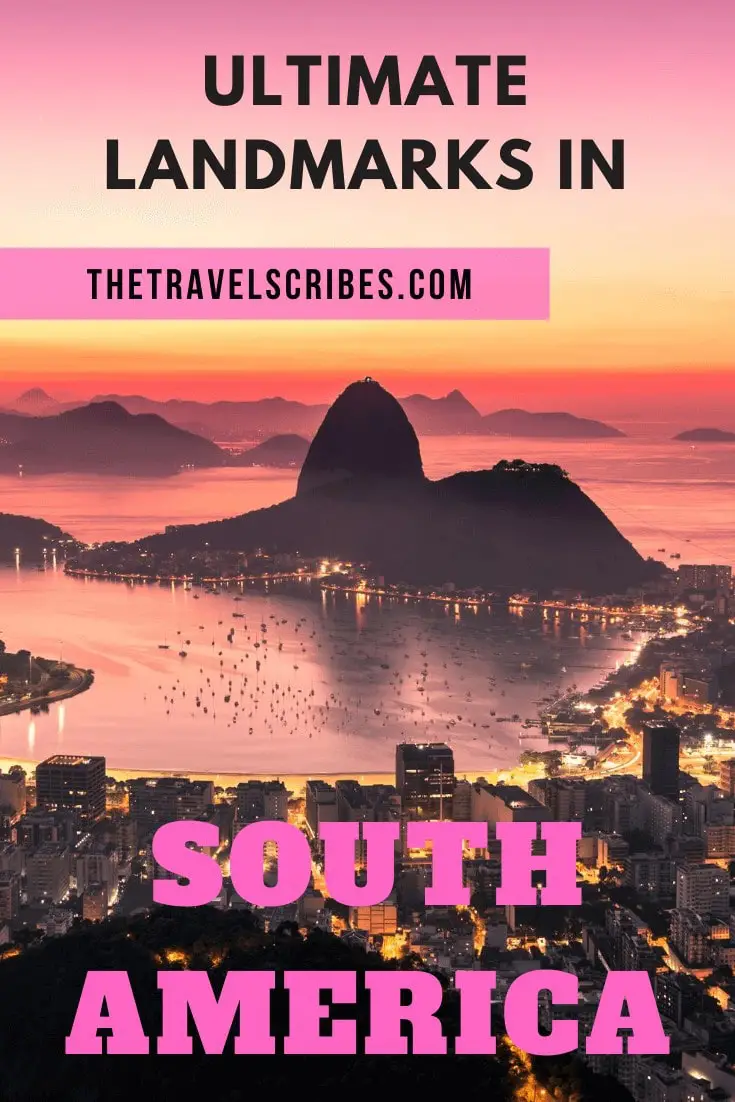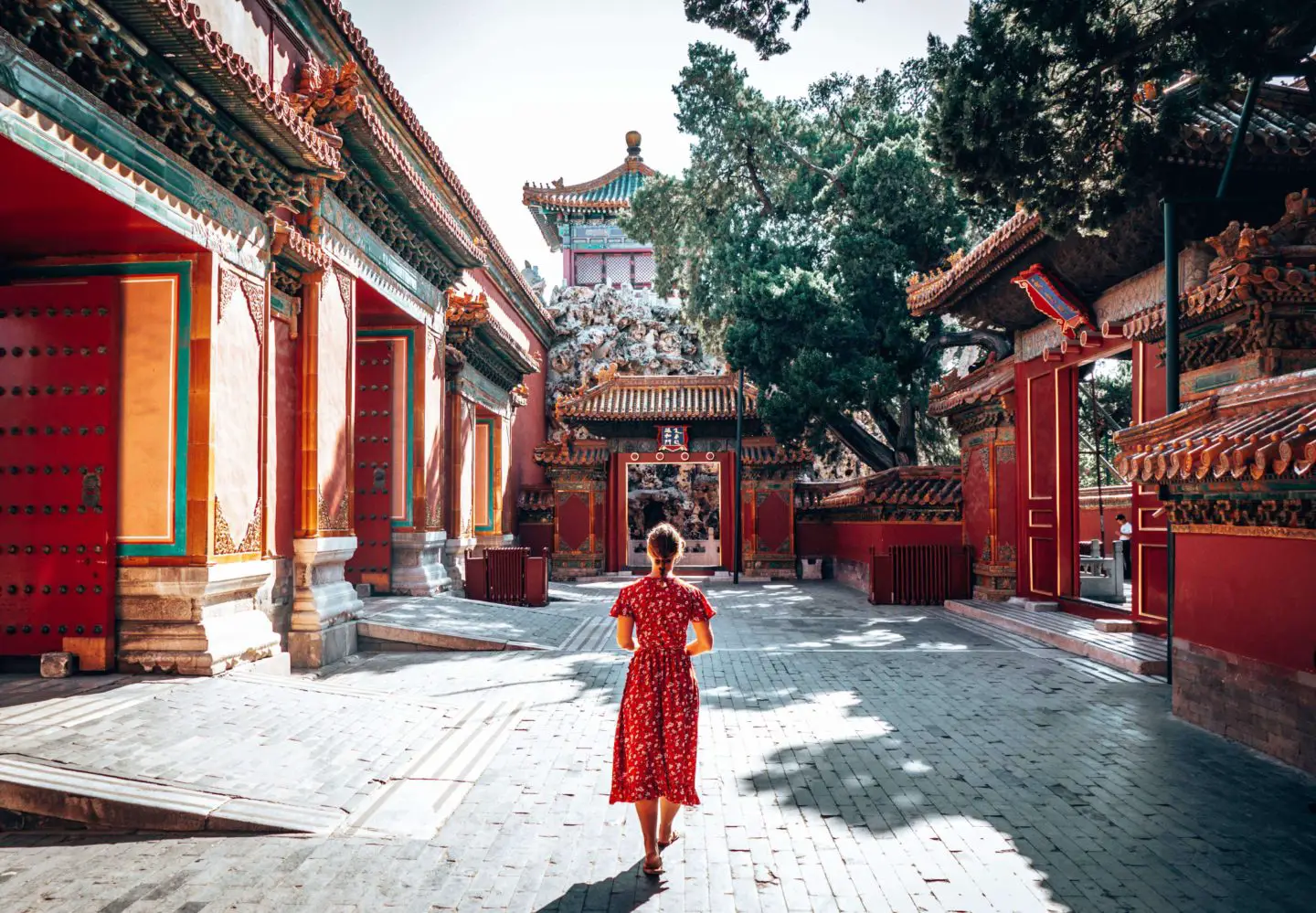From Angel Falls to the Amazon Rainforest, South America is absolutely crammed with iconic places and landmarks to visit; breath-taking natural (and man-made) sights that are worth the trip alone. We’ve only had the luxury of exploring three countries on the continent – Argentina, Brazil and Uruguay – and really want to tick more South American landmarks off our list.
With that in mind, we enlisted the help of some of the world’s top travel writers and bloggers, to help curate this guide to the must-visit landmarks in South America. Read on to find out which 25 cracked the proverbial nod…
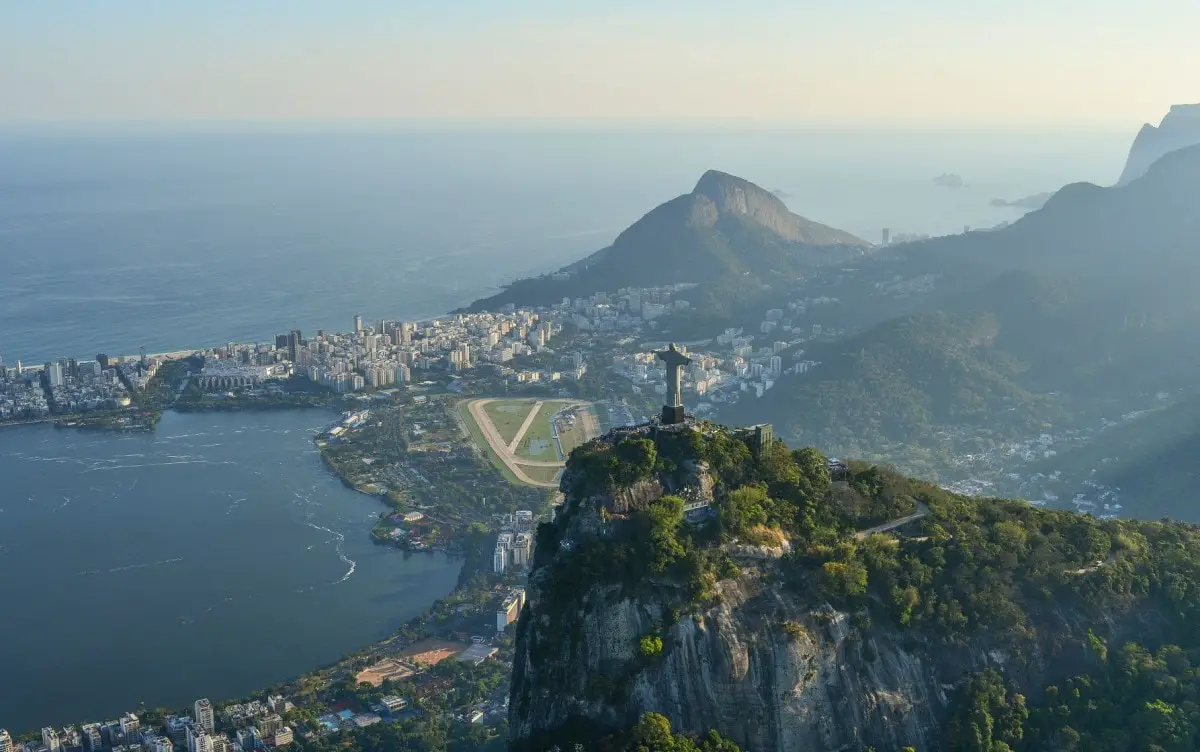
Read next: Which landmarks from South America made it onto our world’s most famous landmarks article?
Skip ahead
Our top 10 Landmarks in South America
If we had to narrow the list down and deliver our ten top South American landmarks (trust us, it’s a difficult task!), here are the ones that make it onto our list:
- Easter Island Statues
- Machu Picchu
- Angel Falls
- Amazon Rainforest
- Salar de Uyuni
- Christ the Redeemer
- Iguazu Falls
- Galapagos
- Nazca Lines
- Colca Canyon
Easter Island Statues
Explored by Erika from Erika’s Travels
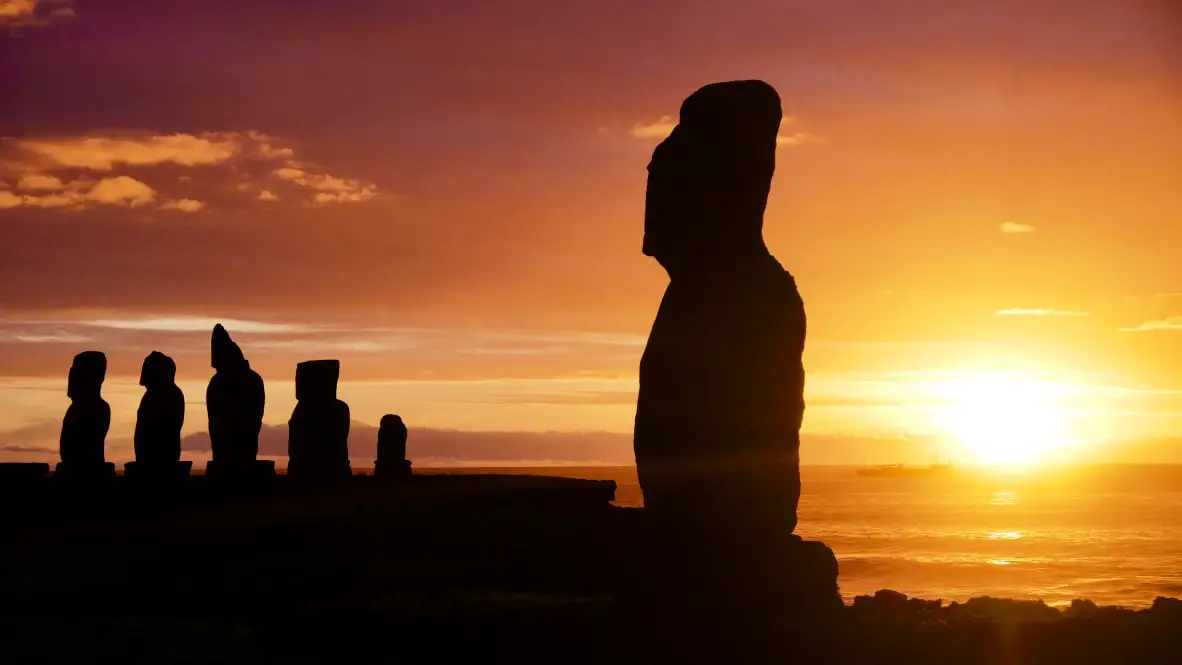
There are few places in the world that can rival Easter Island’s magic. Renowned for the mysterious and massive moai statues that litter its shores, the island is a place that has long captivated the imaginations of travellers.
The small Chilean territory, known locally as Rapa Nui, is one of the most remote places on Earth. It lies in the heart of the Pacific Ocean, roughly 3,700 kilometres from the coast of South America.
Rapa Nui National Park covers much of Easter Island’s surface. The park features stunning volcanic landscapes, sweeping ocean vistas, and megalithic statues that have baffled historians for centuries.
The UNESCO-listed moai statues are Easter Island’s main tourism draw. Though there is still much speculation about why and when they were built, general consensus suggests that the statues date back to the 12th century and represent the island’s Polynesian ancestors. Many of the statues are more than 30 feet tall and weigh upwards of 80 tons. Each has unique facial characteristics.
Nearly 1,000 stone statues litter the volcanic landscapes of Rapa Nui National Park. Some of the statues stand erect on ceremonial platforms. Others lie half-finished and partially submerged underground.
Particular statues of interest are the sunrise-facing cluster at Ahu Tongariki, and the unfinished moai at the Rano Raraku quarry.
The moai statues of Rapa Nui reveal a rich civilization of master craftsmen and engineers. Their production and transportation is considered to be one of humankind’s most remarkable feats.
Kaieteur Falls, Guyana
Explored by Steph from Worldly Adventurer
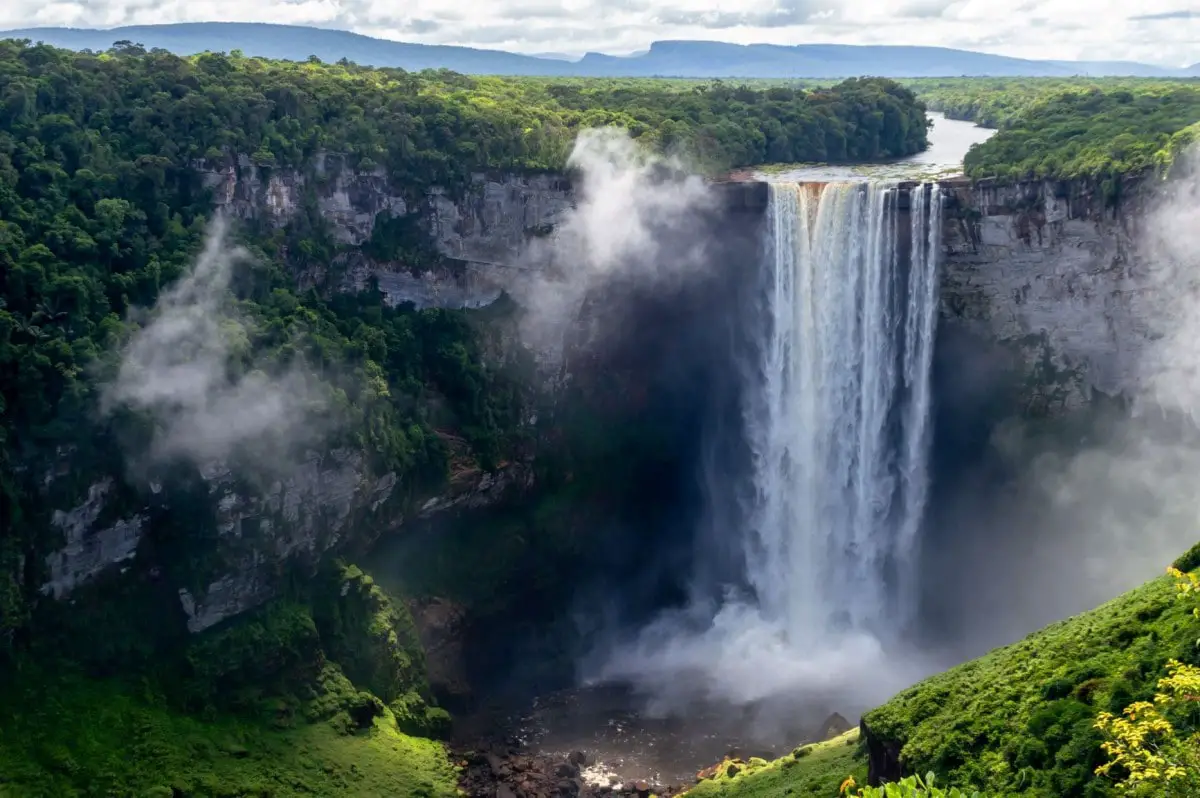
There are few South American landmarks that are quite so spectacular and under-the-radar as Kaieteur Falls. Located in the jungle interior of little-visited Guyana, these magnificent waterfalls count as the largest single-drop falls by volume – with an average flow of about half an Olympic swimming pool every second. It’s also superlative in stature, coming in at five times higher than Niagara Falls.
But a large part of Kaieteur Falls’ appeal as one of Guyana’s unmissable tourist attractions is how remote and untouched the land around it is. Buried in practically impenetrable jungle, Kaieteur Falls is only accessible by light aircraft from the capital city, Georgetown, or by a multi-day trek through the rainforest. The views of the crashing falls and thick vegetation surrounding it as you approach from the air are sensational.
When you arrive, a number of viewpoints offer different perspectives on the falls and, because of how few tourists visit Guyana, you’ll be unlucky if there are more than a dozen other tourists. While you’re there, keep an eye out for the Guianan cock-of-the-rock, a tangerine-coloured bird that has mating spots inside Kaieteur Falls National Park.
Water levels are highest – and the falls are at their most magnificent – during the rainy season (May to August), although the experience will be unforgettable whenever you visit.
Machu Picchu, Peru
Explored by Monica from This Rare Earth
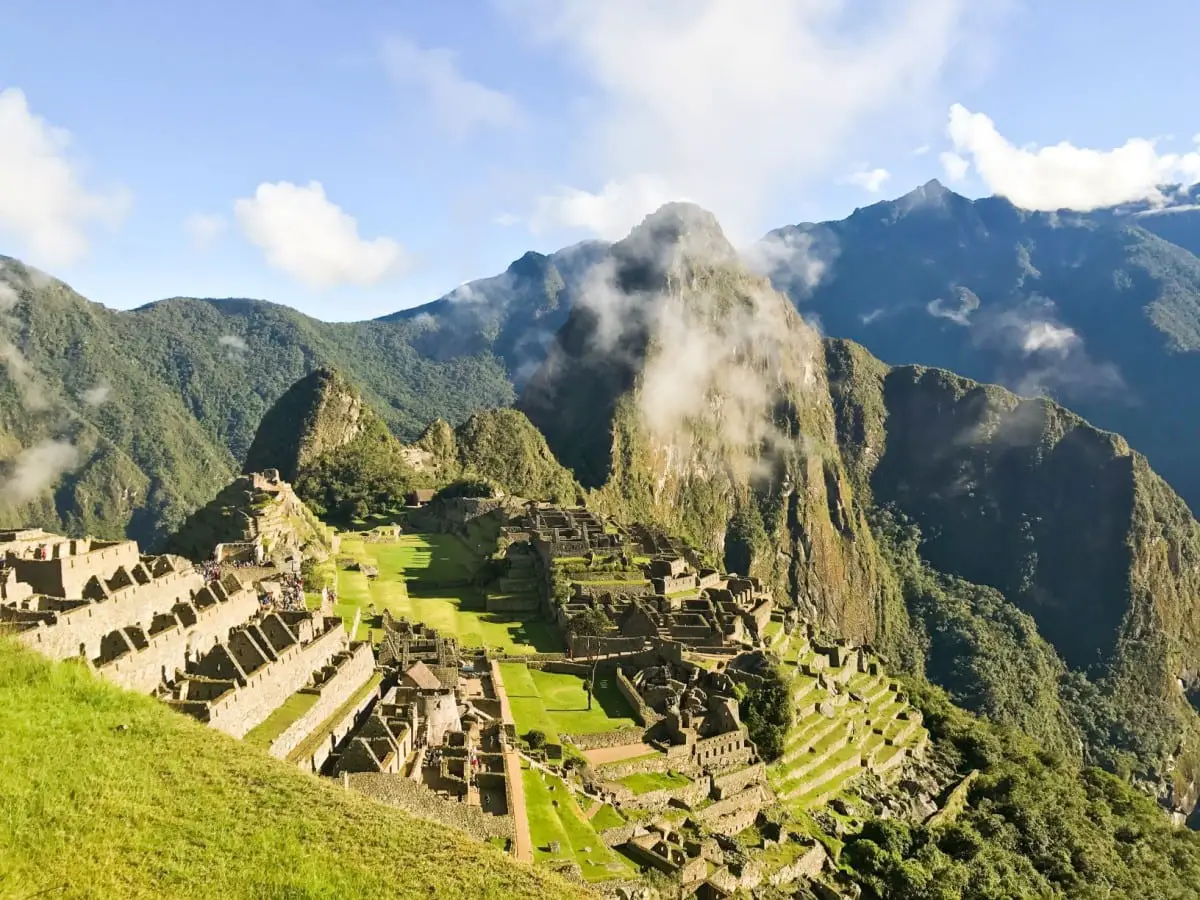
One of the most iconic landmarks of all time in South America is Machu Picchu in the Andes Mountains of Peru. Countless people are familiar with the image of a traveller standing on a hillside, with the ancient Incan ruins sitting behind them. There is a reason why this place and this image has become so well-known; it truly is a breath-taking experience to see the ancient city first-hand, in the fog of sunrise, overlooking a steep cliff.
Machu Picchu was originally built in the 15th century by the Incas, and the name in Quechua means “Old Mountain”. Over 150 buildings remain at the site, from houses to baths to temples. The Incas were incredible builders, and the huge stones are thought to have been pushed up the mountain side by hundreds of men. I was fascinated to learn about their masonry techniques, well beyond their years and still impressive today. The exact use of the site is still debated and somewhat unknown.
You can reach Machu Picchu by both bus – traveling up a steep and windy mountain road – or by trekking the Inca trail. If you have the chance, I highly recommend hiking the Inca trail and arriving to the site for sunrise. Arrive early and you can get one of the limited permits to climb the Huayna Picchu peak, overlooking the ruins from an additional 1,000 foot height.
Quebrada de Humahuaca
Explored by Claudia from My Adventures Across The World
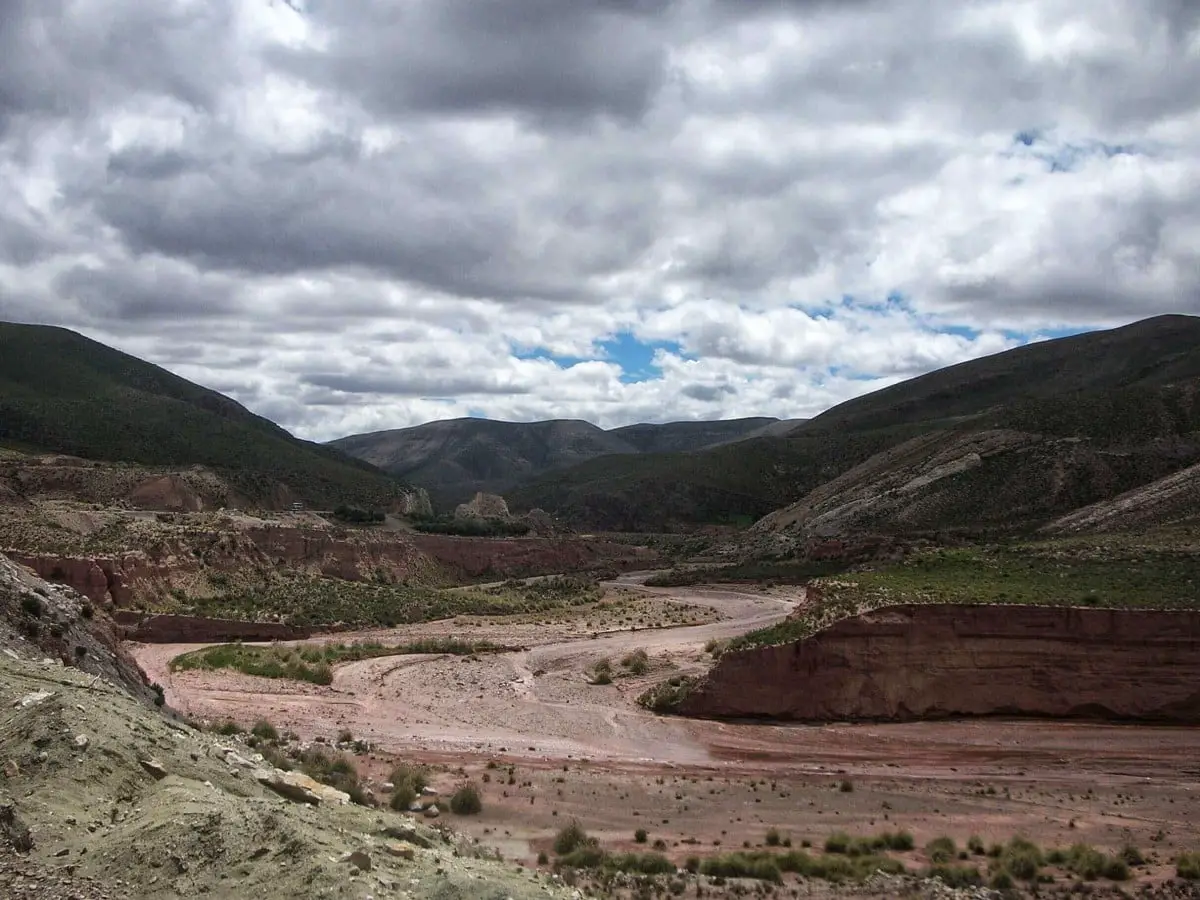
The Quebrada de Humahuaca is one of the most beautiful places to visit in Argentina. Easily reached from Salta, it’s the perfect place for a road trip, which will give you the opportunity to admire the breath-taking landscapes, the small villages, and – more than anything else – appreciate the unique atmosphere.
As already said, one of the highlights of the Quebrada de Humahuaca is the many picturesque villages. Purmamarca is a tiny one but stopping there is a must for it has a lovely, lively and colourful souvenir market. The village is located at the foothill of the Cierro los Siete Colores.
Another village worth stopping by is Maimara, at the foothills of La Paleta del Pintor. As the name may give in, this mountain is so colourful that it looks like a painters’ palette.
Tilcara is one of the largest towns. Stop there to visit the Pucara, an Inca settlement which has for the most part been reconstructed for tourist purposes. Tilcara is also home of a fun traditional carnival.
Finally, there’s Humahuaca. Set at 3000 meters above sea level, this is the largest town in the area and a fun place to explore the market and observe local life.
Give yourself at least 3 full days to explore the Quebrada. The best way to visit is independently on a rental car. Alternatively, opt for a guided tour departing from Salta.
Angel Falls, Venezuela
Explored by Lee from The Travel Scribes
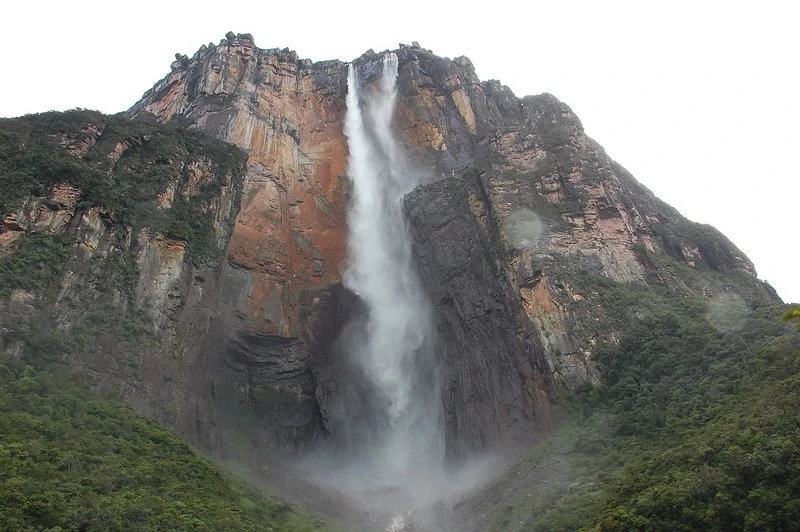
Photo Credit: Ollie Harridge / Flickr
No list of the most iconic landmarks in South America would be complete without the tallest waterfall in the world.
Angel Falls cascades from a height of 979 metres – to put that into perspective it’s around 3 times the height of the Eifel Tower!
Located in the jungles of Venezuela, the waterfall drops off the flat-topped plateau of Devil’s Mountain.
Want to find out more about the Eifel Tower and other French landmarks? Check out this list of the best landmarks in France.
Ushuaia, Argentina
Explored by Sandra from BlueMarble Vagabonds
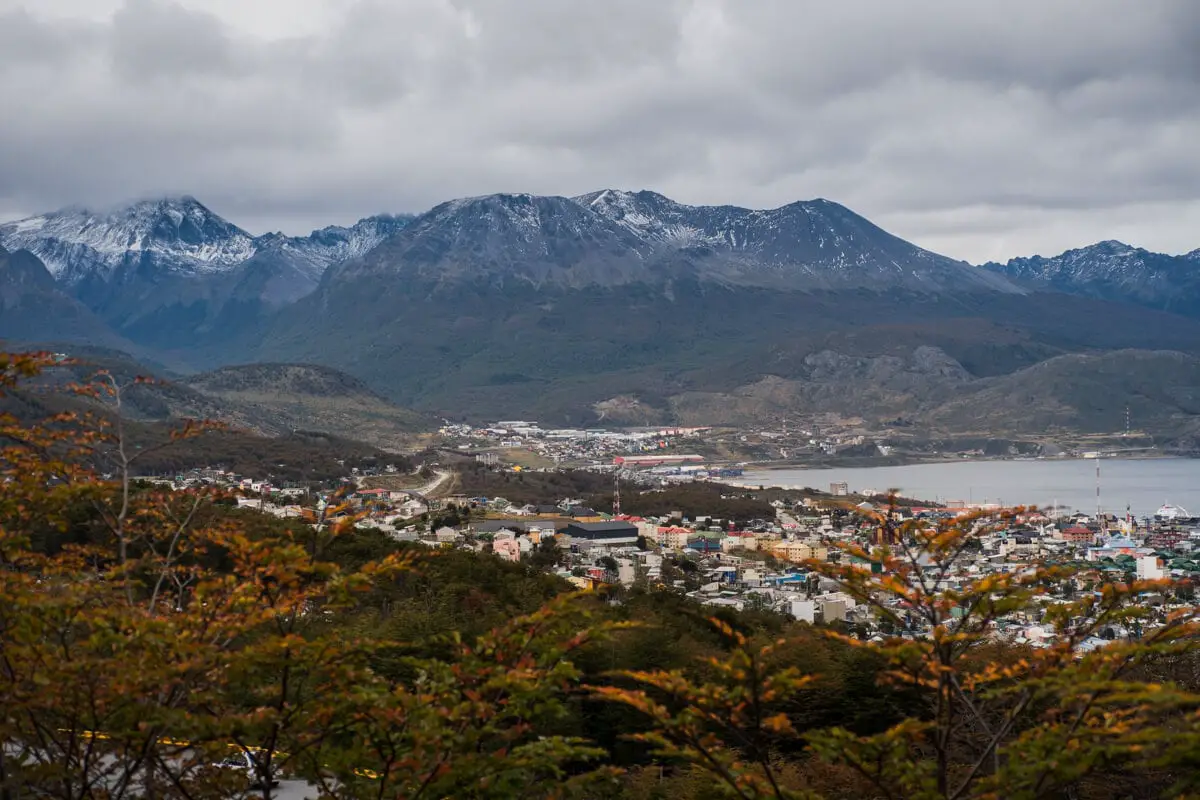
Ushuaia is a city on the southern coast of Tierra del Fuego, an archipelago at the tip of South America, part of which makes up the infamous Cape Horn.
Inhabited already 10,000 years ago, it was unofficially founded by British missionaries in the 19th century and by the end of the century it became a penal colony with a prison which operated until 1947. The former prison is today the most important (and interesting) museum in the city.
These prisoners were basically “forced colonists” who built the city with timber from the surrounding forests. The railway which was used to transport timber to the town is today one of the main attractions in the city and known as the southernmost railway in the world.
What was once not a very pleasant place to live, is today one of the best landmarks in Argentina and one of the most unique towns in Patagonia. Besides various museums, there are plenty of hiking trails around the city (or in nearby Tierra del Fuego National Park) and you can drink tea with a view on the glacier or indulge in the southernmost craft beer in the world.
Despite a smaller Chilean settlement Puerto Williams being located south of the city, Ushuaia is still widely advertised as “Fin del Mundo” (The End of the World). And if you’re traveling with your beloved one, this place should surely be added to your bucket list – after all, “going to the end of the world for you” will truly have a meaning after coming here.
Colca Canyon, Peru
Explored by Roshni from The Wanderlust Within
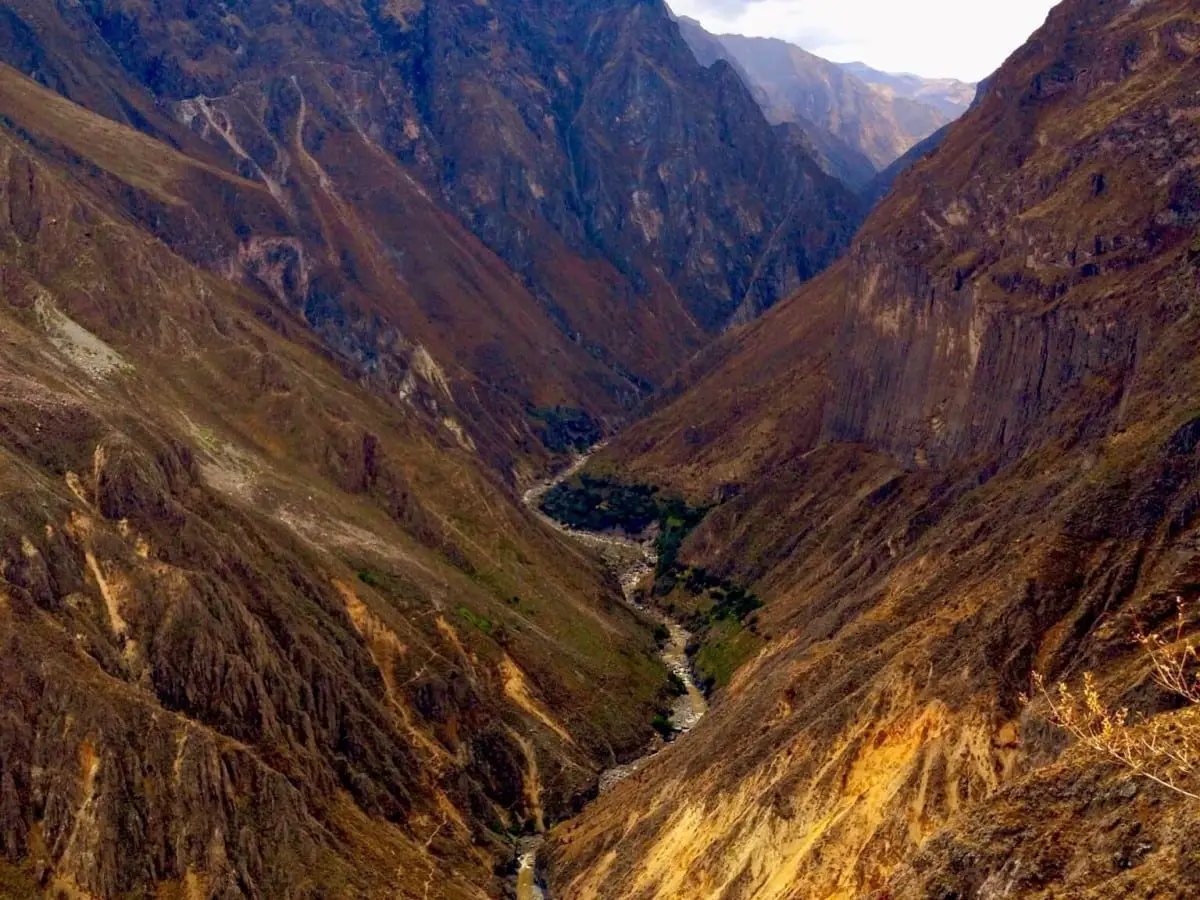
Surprisingly to most of the world, Peru is home to one of the deepest canyons in the world (3,270 metres or 10,730 ft).
Colca Canyon or Cañon del Colca as its locally known, is situated close to the city of Arequipa in the south of the country. Colca Canyon is the third most visited destination in Peru and is best explored by foot on one of the best hikes in South America.
Located around six hours drive away from Arequipa, most visitors choose to take part in a two- or three-day trek (if you want to take it slow) as the elevation gain and loss is very high.
Colca Canyon is also home to the Andean Condor, which can be seen from close range at the Cruz del Condor viewpoint, which is often visited on Day 1 of the hike. The Andean Condor lives for around 70 years and has a wingspan of 2.1 to 2.7 metres (7 to 9 ft), making it one of the largest flying birds in the world. It is commonly referred to as the “Eternity Bird,” as the Andean Condor is a symbol of long life and eternity.
Another popular attraction within Colca Canyon is the La Calera hot springs located in Chivay. These natural hot springs are visited on the final day of the trek and are perfect for soothing your legs after the strenuous uphill hike.
Pelourinho, Brazil
Explored by Moheb The Wanderer Pharaoh
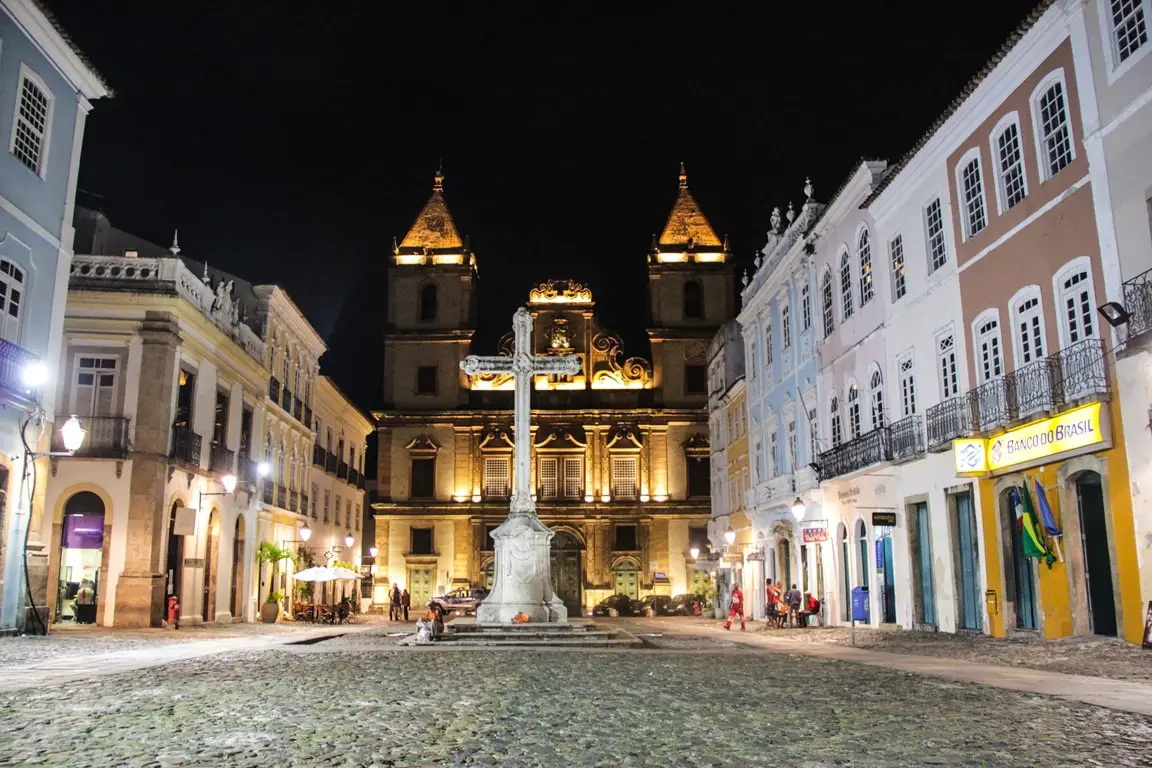
Pelourinho is the historic centre of Salvador de Bahia. Salvador was the first capital of Brazil during the colonial era and a major slave market. Pelourinho means “the whipping post” because it was the square where slaves were punished and whipped. It is now a UNESCO World Heritage Site.
Pelourinho is the cultural hub and the beating heart of Salvador de Bahia. Its streets are filled with live authentic music, drumming parades and capoeira circles. Capoeira is a martial art and dance that evolved in Salvador de Bahia by the slaves as a ritual practice to connect with ancestors.
Pelourinho is very famous for its traditional food stands. The most authentic and delicious experience in Pelourinho is eating Acarajé. Acarajé is a traditional dish which Salvador is famous for. It is a deep-fried patty of crushed black-eyed peas, palm oil, pureed onions and stuffed with dried shrimp. Pelourinho is also a good place to try the Caipirinha, which is the Brazilian national cocktail. Caipirinha is made with Cachaça – fermented sugarcane juice, sugar, and lime.
Pelourinho is also characterized by its colourful colonial buildings and historic monuments. São Francisco Church and Convent is a historic and iconic church located in Pelourinho. It is an example of beautiful Portuguese colonial architecture. The first church on the same site was built in 1587 by the Franciscans, but it was destroyed during the Dutch invasion in the 17th century. So, the current São Francisco Church and Convent was built in 1686.
Amazon Rainforest
Explored by Kristin from Adventures with Ensuite
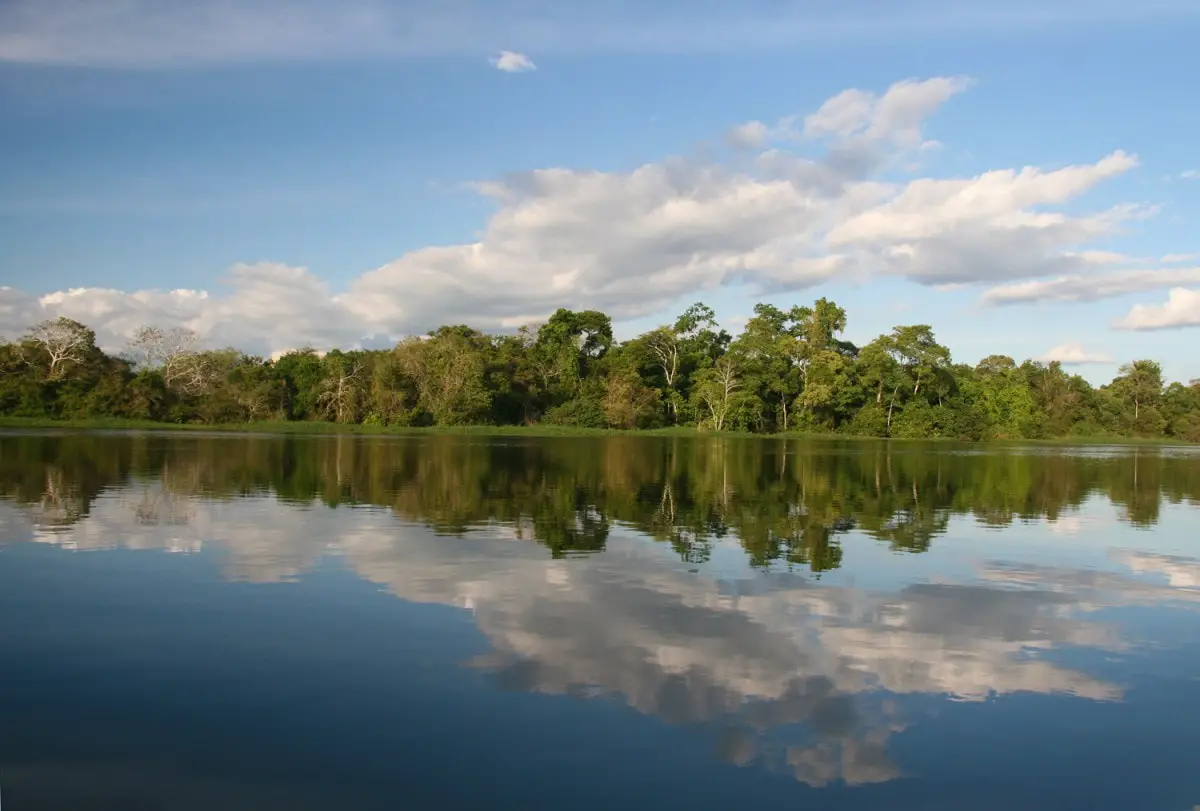
The Amazon rainforest is roughly the size of the 48 lower states of the USA and stretches into 9 countries – Brazil, Peru, Colombia, Venezuela, Ecuador, Bolivia, Guyana, Suriname and French Guiana.
Not only is it the largest freshwater wetlands in the world, and is home to the mighty Amazon river, it has unparalleled biodiversity with one in ten known species found here.
You could believe that a trip here would be all about seeing the wildlife, but it can be surprisingly difficult to find. The other main reasons to come is for the fantastic variety of plants, trees and the scenery.
A visit is easiest to arrange from Brazil, Peru or Ecuador, but getting a true rainforest experience requires a bit of travel. The journey often involves both local flights and long boat trips, so it is important to allow for some flexibility in your itinerary for delays.
60% of the rainforest is located in Brazil where the gateway to the Amazon is through Manaus. If you are looking for a trip to a truly off the beaten path part of the Amazon consider staying at Uakari Lodge in the Mamirauá Reserve.
The two seasons in the Amazon are often described as rainy and rainier and there are pros and cons for both. The rainiest season is from December to April but that is also when most fruits grow, drawing the animals out of the forest.
Regardless of when you go, the sheer scale and isolation of the Amazon will not fail to impress.
Salar de Uyuni, Bolivia
Explored by Cazzy from Dream Big, Travel Far
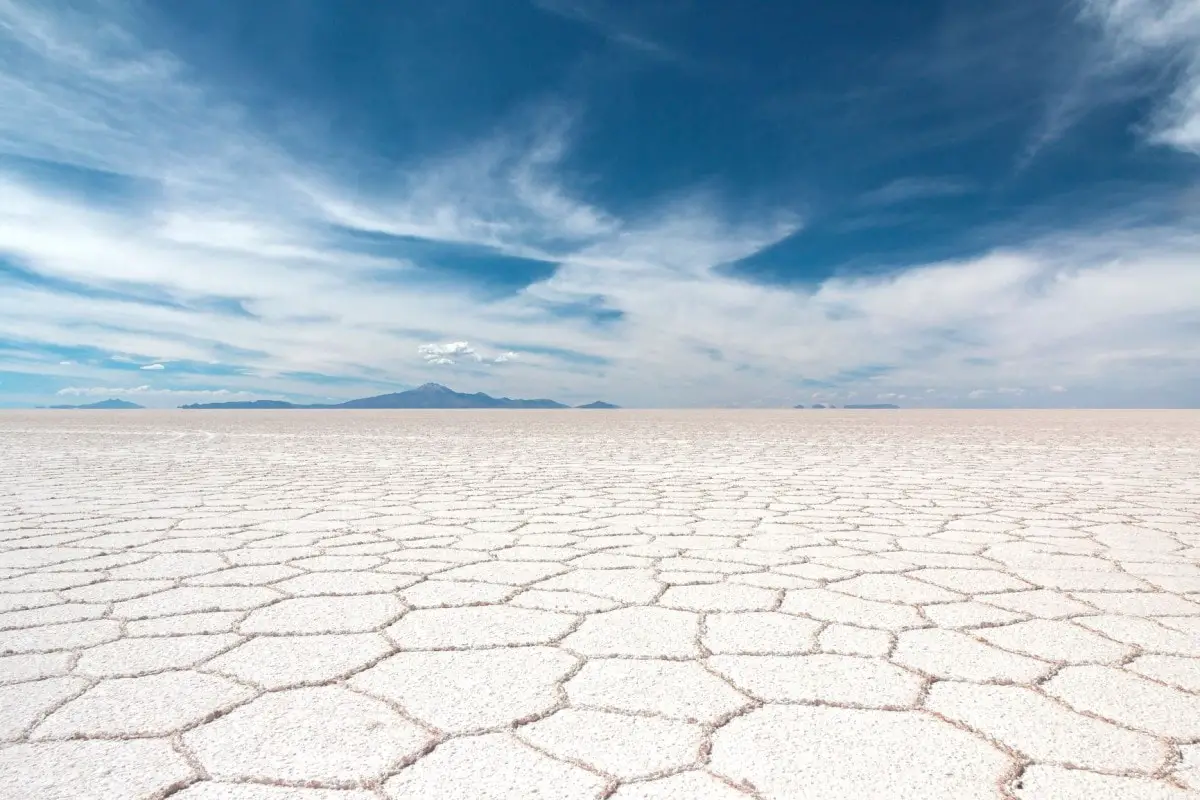
One of the must-see spots in all of South America is the Bolivian Salt Flats, also known as Salar de Uyuni. This is essentially the world’s largest mirror and it’s the biggest salt flat in the entire world. A visit here is definitely one of those bucket-list moments and it’s an awesome place to visit.
This unique spot is a brilliant place to visit all year round, and different seasons bring different views. If you visit when it’s wet (January to April) then you’ll experience the amazing mirror effect of the Salt Flats, and when you visit when it’s dry, you’ll get to see the detail of the shape of the Salt Flats and have some fun creating weird and wonderful illusion pictures!
Since the Salt Flats are Bolivia’s most famous attraction, getting there is no issue, and most people opt for a tour. You can either opt for a 3-day tour that takes you through several natural attractions in the area, such as, colourful lagoons in the Eduardo Avaroa Reserve, and hot springs, or you can take a day tour from Uyuni, which is the closest town to the Salt Flats. Either way, make sure you bring some fun props with you and have your camera battery charged.
Nazca Lines, Peru
Explored by Sharon from Dive into Philippines
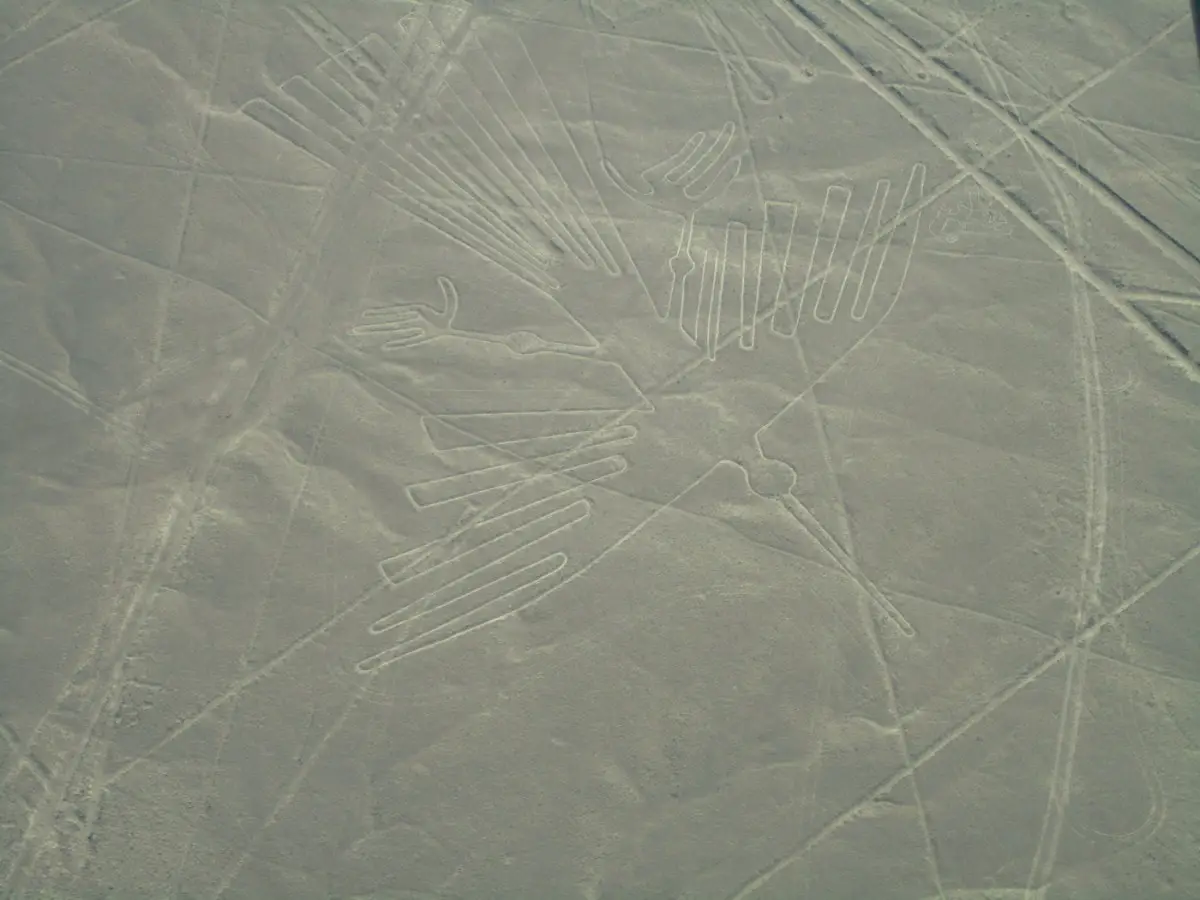
The Nazca Lines are one of the most mysterious and famous landmarks in Peru. Located in the desert 200 miles southeast of Lima near the town of Nazca, these “lines” are depressions and incisions in the desert made by removing pebbles and leaving different coloured dirt exposed. There are hundreds of lines, 300 geometric figures and 70 animal and plant designs!
The lines were created between 500BC and 500CE and no one really knows how or why they were created. They were largely forgotten about until flights started over Peru and pilots spotted them.
To see the lines, you need to get up high! From the ground, they are generally not distinguishable, and you can’t see the patterns they make. There are some hills and a platform you can visit to see some of the lines. A good starting point is the Nazca Lines Observation Tower on the road into Nazca from the coast which is a platform 42 feet tall with stairs to the top. It’s a quick, easy and affordable way to see three of the geoglyphs – the Tree, Hand and Lizard.
However, for the best views, nothing replaces a scenic flight over the desert checking out the lines and designs. There are many 30-minute flight options starting from about US$80 that will fly you over the lines. There are many to see so if you have a particular one you would like to see, make sure you book a flight that will take you to that one.
Galapagos
Explored by Daniel and Ilona from Top Travel Sights
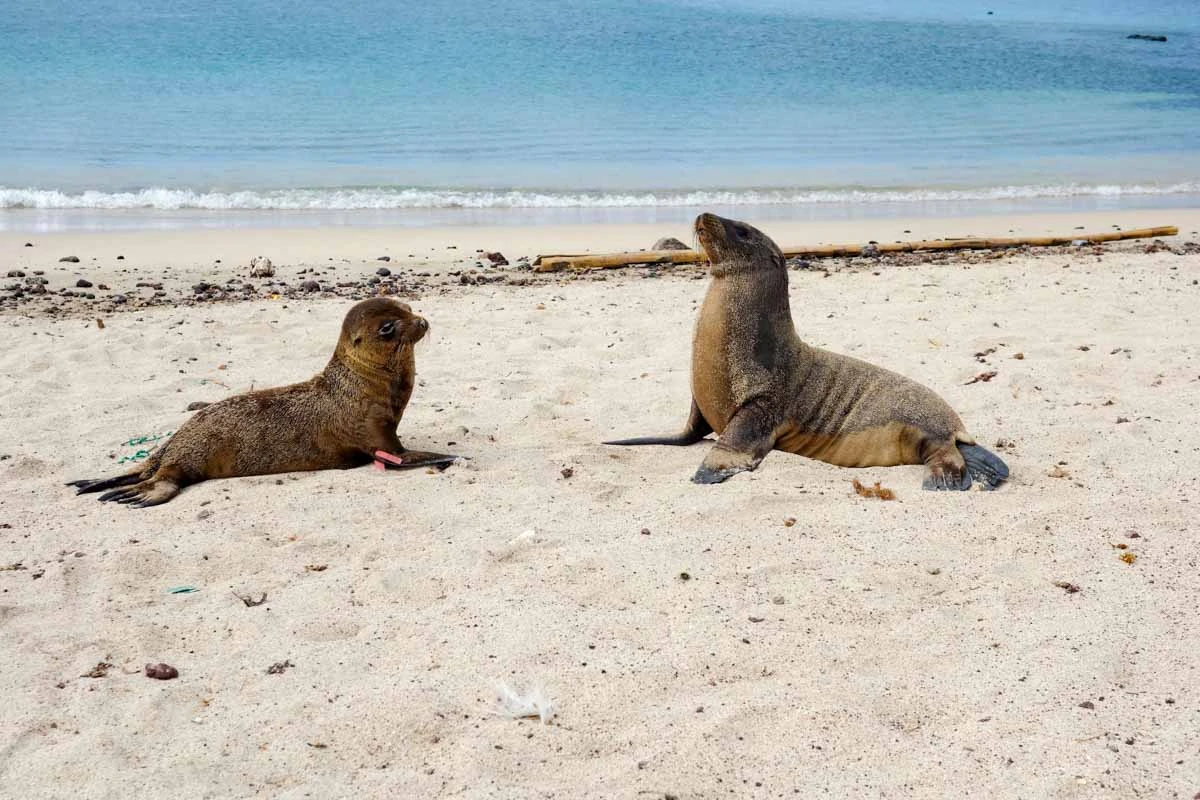
One of the most iconic places to visit in South America is Galapagos. You can fly here from mainland Ecuador in just one and a half hours, but it feels like arriving in a completely different world.
The Galapagos Islands are famous for their wildlife, and you’re guaranteed to see many animals here. Sea lions are everywhere, no matter where you go. They breed in the middle of town on San Cristobal Island, hang out on benches at the harbour of Santa Cruz Island or come up to play with you while you swim in the sea.
You’re also guaranteed to see giant tortoises and lots of marine iguanas. Did you know that they sneeze to get rid of excess salt? Don’t be surprised if one sneezes right into your face!
While in Galapagos, make sure to visit the Charles Darwin Research Station to learn more about the unique ecosystem in the archipelago. Here, you can also see the conserved body of Lonesome George, the last of his species, as well as many living giant tortoises. And you can learn more about the conservation efforts done by scientists and the government, to preserve this unique environment.
Galapagos also features endless white beaches. On every island, you will find a beach where you can relax in the sun while watching marine iguanas walk past.
No matter if you want to see wildlife or take a day off at the beach, you will enjoy your time on Galapagos.
Lençóis Maranhenses, Brazil
Explored by Gobor from Surfing the Planet
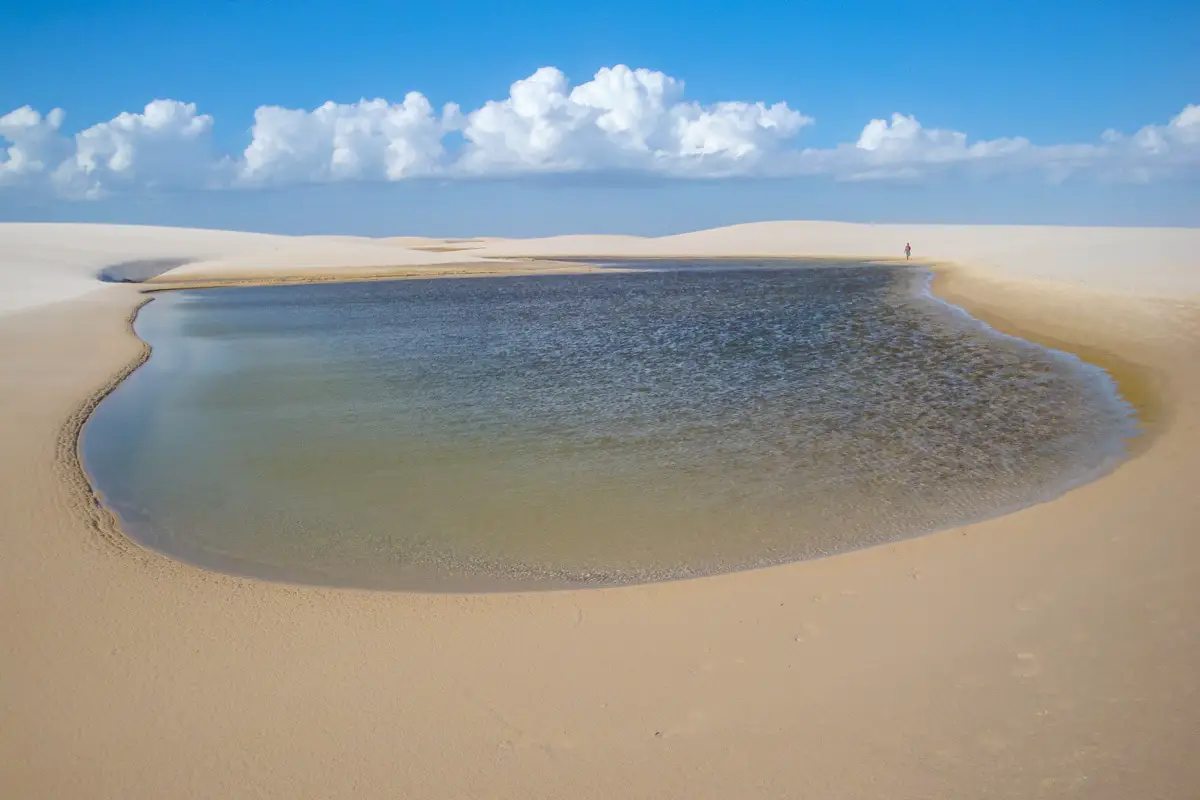
There are many fascinating natural landmarks in South America, but probably one of the most unique of them is the Lençóis Maranhenses National Park. Situated at the northern edge of the continent, it’s one of the most beautiful natural parks to visit in Brazil. It’s a large sand desert, but as a peculiarity, it has freshwater lagoons between the dunes that fill up in the rainy season.
It’s hard to imagine a more surrealist landscape than this one, and one would think at first glance that it’s some kind of an illusion. For those who like traveling off the beaten path, the other attraction of the park is that it never gets many tourists. The main reason is that it’s not easily accessible, most travelers get there after a couple of days of traveling in difficult terrain (often impassable after the tropical rains) from Jericoacoara to Bairerrinhas, a small town near the park.
Although you can take a 4WD tour from Bairerrinhas to visit some of the main sights in the park, we would recommend you to get a public boat to Atins, a local fishermen’s village and from where you can explore the area on a multiple-day hike with a local guide.
Torres del Paine, Chile
Explored by Jiayi from The Diary of a Nomad
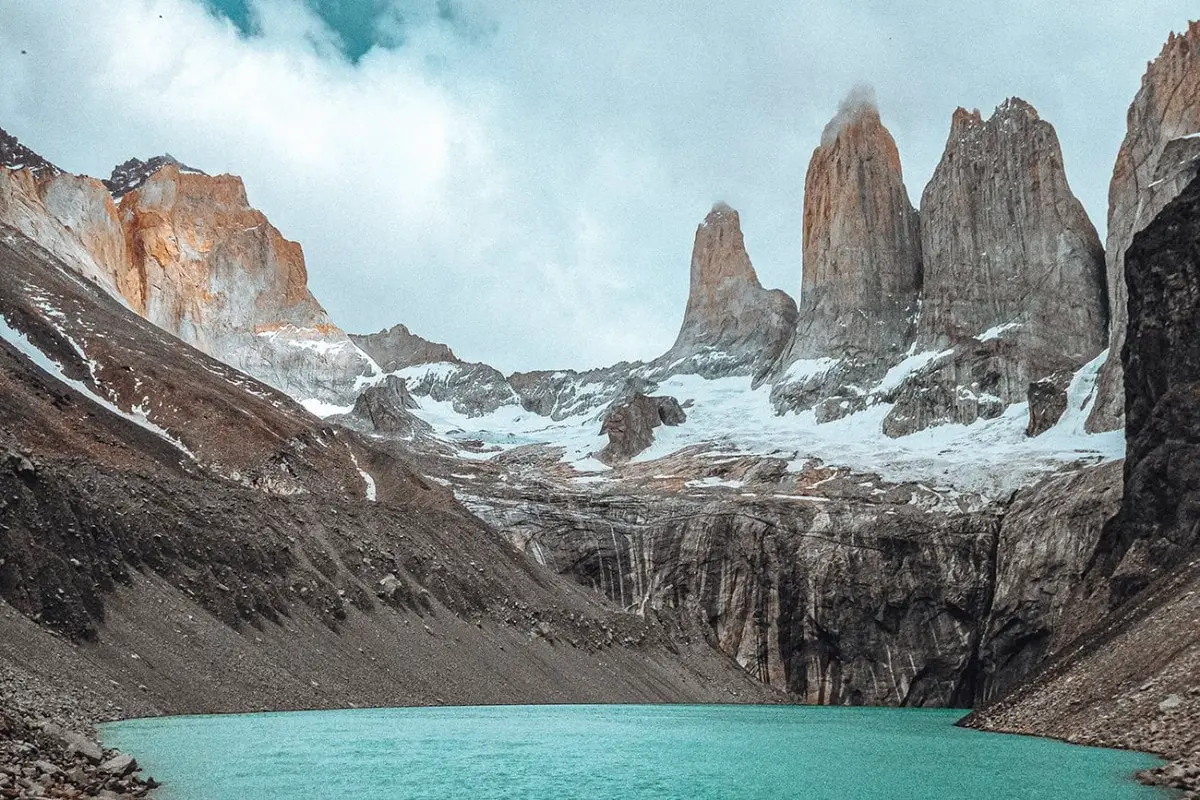
One of the most iconic landmarks in South America is the beautiful Torres del Paine National Park. Located in the Chilean Patagonia, this place is a true dream holiday destination for anyone who enjoys nature, hiking, and relaxation. The breath-taking landscapes you’ll find here are unbeatable; they’re truly some of the most gorgeous sceneries on earth.
You cannot visit Torres del Paine without doing some of the popular treks there, such as the W Circuit or the O Circuit. If you prefer doing a shorter day-trek, you can simply hike to the base of the iconic towers — the Cordillera Paine. This 8-hour trek is difficult and involves a lot of steep ascents on rough terrain, so be sure to train for it. The view at the end is completely worth it though, and you cannot visit Torres del Paine without seeing the postcard view of the three towers!
Some of the other fun things you can do in Torres del Paine are rafting, horseback riding, and glacier hiking! You can also take a 3-hour boat ride to the Gray Glacier, where you’ll see some unforgettable views of majestic floating icebergs and mountains.
Perito Moreno Glacier, Argentina
Explored by Lindsey from Have Clothes, Will Travel
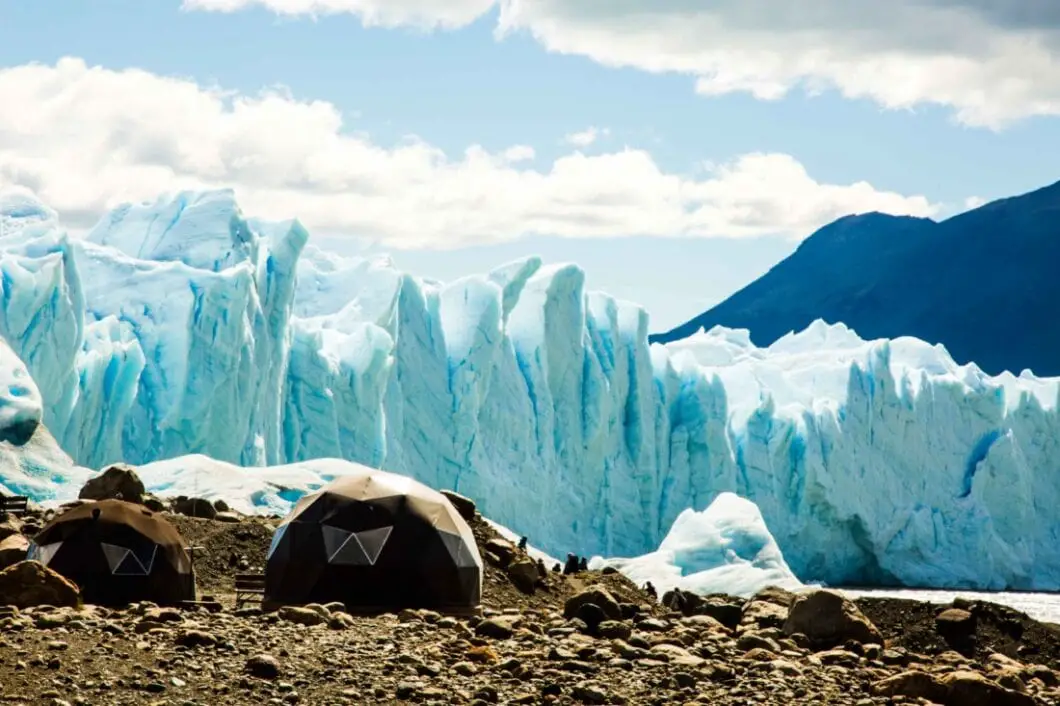
Seeing Perito Moreno Glacier in Argentina is an absolute must-do for your Argentina itinerary. This was one of my favourite travel memories, from not only Argentina but South America in general!
Perito Moreno Glacier, located in the Los Glaciares National Park, is unique because it’s a glacier that is accessible, and it’s actually growing. Experts are still debating as to why Perito Moreno Glacier is growing while many glaciers are regressing.
You can see Perito Moreno via a boat tour or from viewing platforms. The best way to experience, Perito Moreno Glacier, though, is by hiking it!
There are two different ways to hike Perito Moreno Glacier: one is a “Mini Trek” and one is a “Big Ice Adventure.” The Mini Trek is about 2 hours hiking the actual glacier, plus a boat ride to and from the glacier, plus transport to the viewing platforms of the glacier. “The Big Ice Adventure” is about 7 hours on the ice and requires more effort and also harnesses.
Then, at the end of your hike, you’re treated to a glass of whiskey on glacier ice. It’s an incredible experience!
Pão de Açúcar (Sugarloaf Mountain), Brazil
Explored by Wendy from The Nomadic Vegan
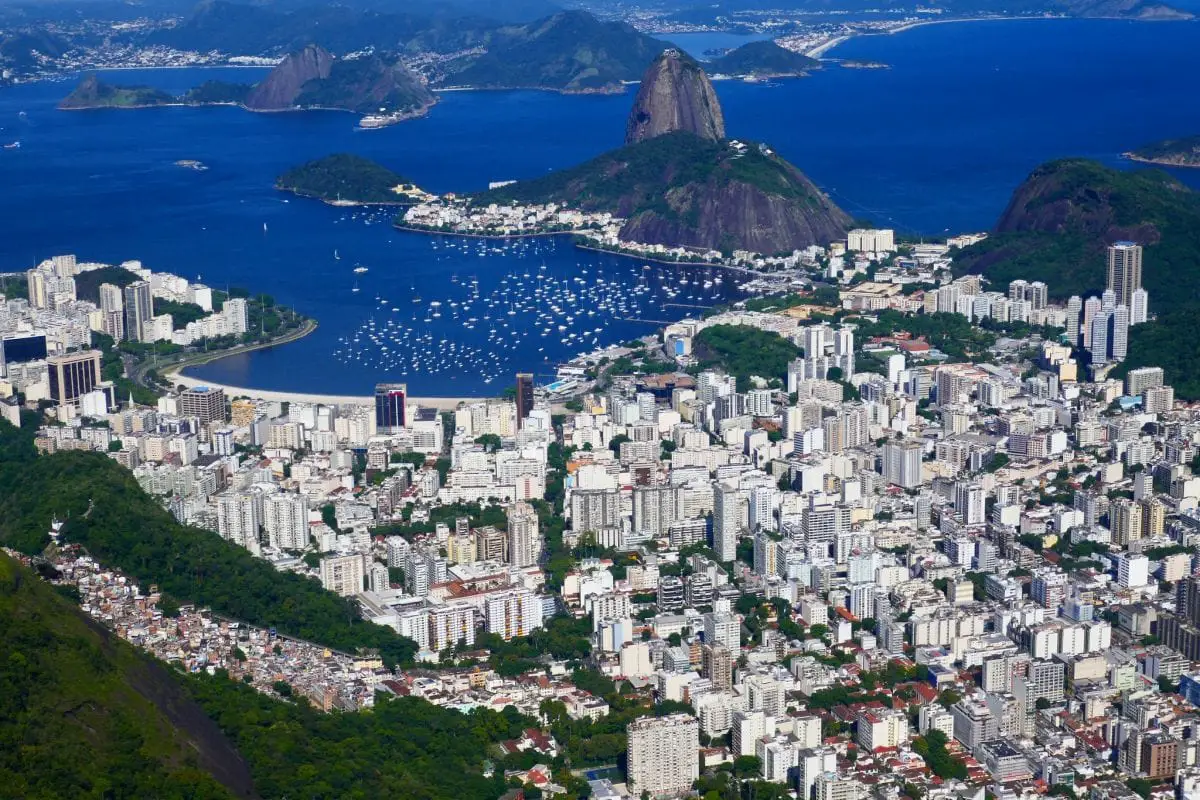
In a city that’s filled with spectacular viewpoints, Sugarloaf Mountain, or Pão de Açúcar in Portuguese, is justifiably one of the most popular vantage points from which to view the amazing beauty of Rio de Janeiro. To reach the top, most people take the cable car, which is the oldest of its kind, built in 1912, and is a tourist attraction in itself.
There are actually two stages of the journey. The first cable car takes you to the smaller mountain next to Sugarloaf, called Morro da Urca, and the second car takes you the rest of the way to the summit. It’s possible to save a few bucks by hiking the first leg, but don’t attempt to climb the rest of the way unless you are a very experienced rock climber!
The hike to the top of Morro da Urca is pretty easy, though, and takes you through lush rainforest on a well-marked trail called the Pista Claudio Coutinho. While it can’t compare with touring the Pantanal or the Amazon, it’s a good spot for birdwatching, and you may even spot some monkeys.
The views from the top of Sugarloaf are nothing short of breath-taking. The only drawback is that you can’t see Sugarloaf itself, one of the most iconic features of Rio’s cityscape. For this reason, I recommend also visiting the Christ the Redeemer statue at the top of Corcovado mountain, from where you’ll see the neighbourhood of Botafogo, the bay, and Sugarloaf.
The Recoleta Cemetery, Argentina
Explored by Maartje and Sebastiaan from The Orange Backpack
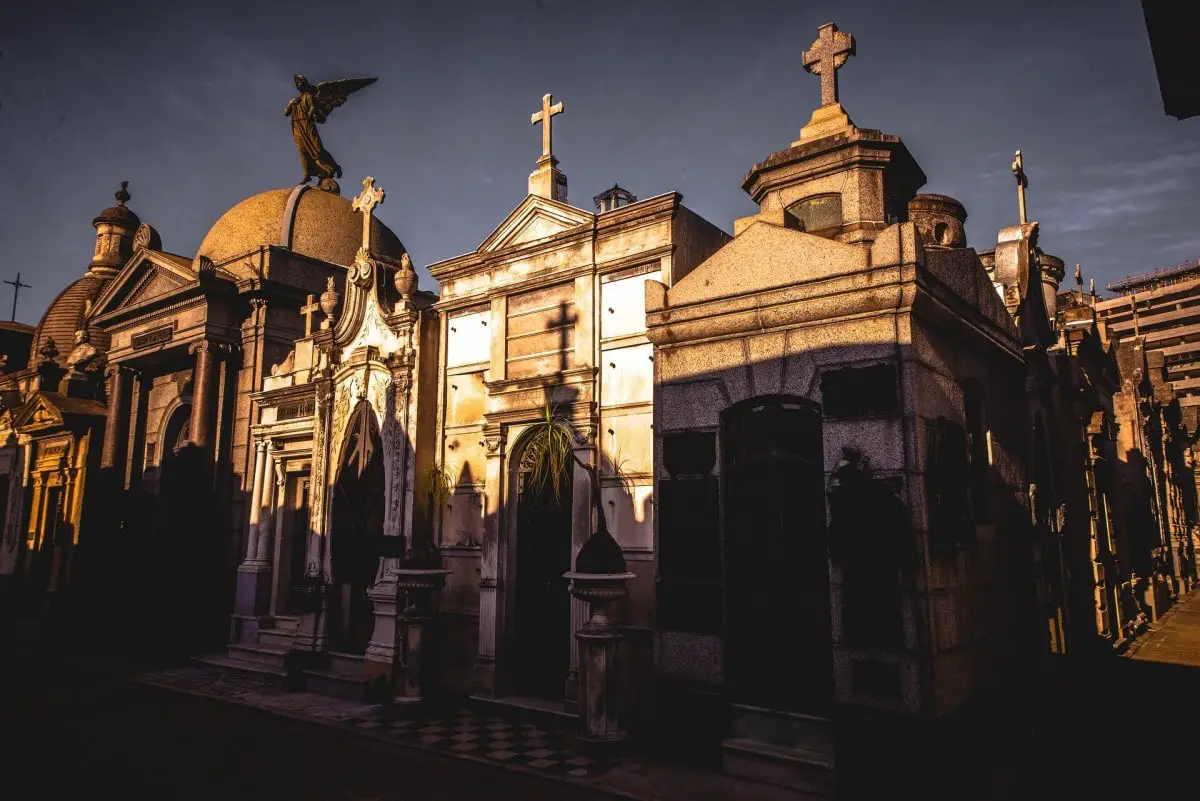
The Recoleta Cemetery is not just one of the most iconic places in Buenos Aires, but a well-known landmark in South America. The famous last resting place of Argentina’s first lady Evita Perón is one of the highlights of any visit to Buenos Aires. It was listed by CNN as one of the most beautiful cemeteries in the world.
The famous cemetery is a beautiful and peaceful place in heart of busy Buenos Aires. It’s located in the Recoleta area, one of the wealthier neighborhoods in BA known for its monumental buildings, embassies and the cemetery with the same name.
Cementario de la Recoleta dates back to the start of the nineteenth century and has been used as a resting place for the rich and famous in Argentina. It’s like a city itself with its small lanes, maze-like layout and monumental graves.
The size is enormous. Recoleta is about 5.5 hectares and has over 4,500 graves. The monumental graves are stunning. Most graves are above ground and most of them have impressive and monumental tombs, decorated with statues, columns and marble.
The cemetery houses many former presidents, Nobel prize winners and writers. But the most famous of all is the former first lady attracting the most visitors at Recoleta. The embalmed body of Evita Perón was buried here many years after her death. Her grave is like a shrine for visitors bringing fresh flowers each day.
Other must-see graves are the ones of Rufina Cambaceres for its beautiful art nouveau architecture, the young Liliana Crociati de Szaszak with its distinctive design and style and the Paz family grave with its black tomb.
Christ the Redeemer, Brazil
Explored by James from The Travel Scribes
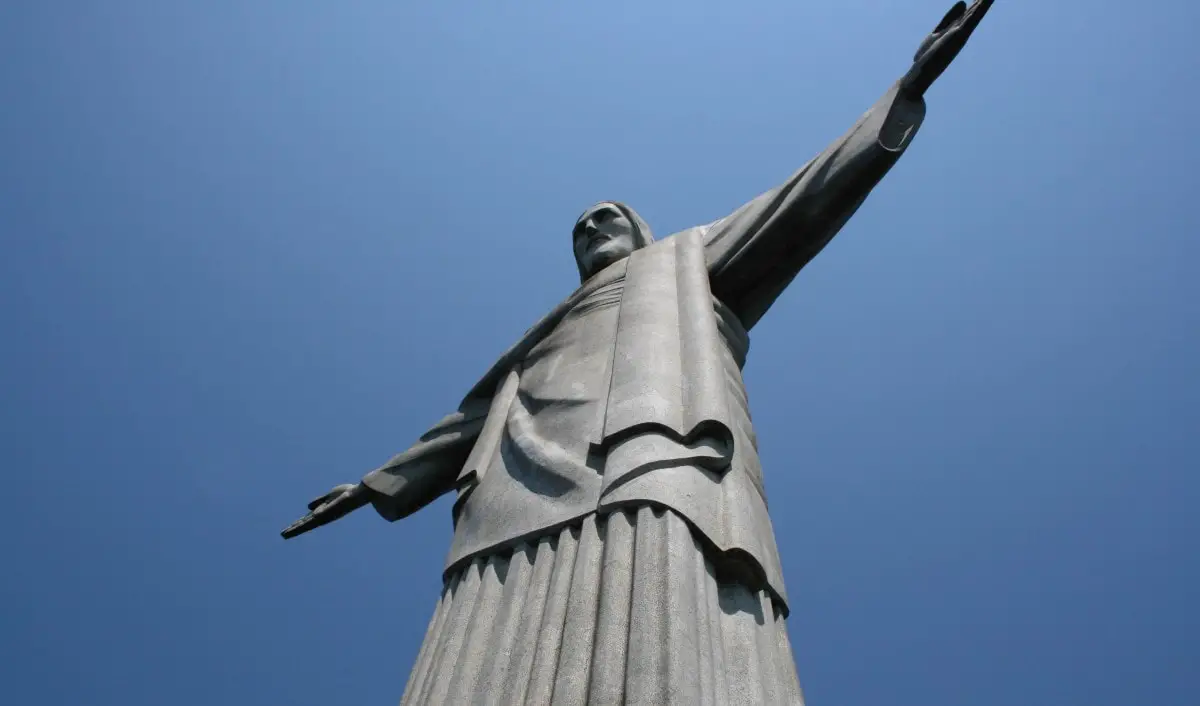
Potentially the most famous landmark in South America is the stunning Christ the Redeemer, sitting proudly above Rio de Janeiro in Brazil.
Having been built in 1931, it is the major tourist attraction in the city, and was added the list as one of the New 7 Wonders of the World.
The soapstone statue of Jesus is perched on Corcovado mountain, and stands at 30m tall, a huge impressive sight, and what’s more is that the location offers some of the best views of Rio too.
Want to learn more about Brazil and its culture? Read our list of Must Read Books About Brazil
Castillo de San Felipe de Baraja, Colombia
Explored by Marika from Clumsy Girl Travels
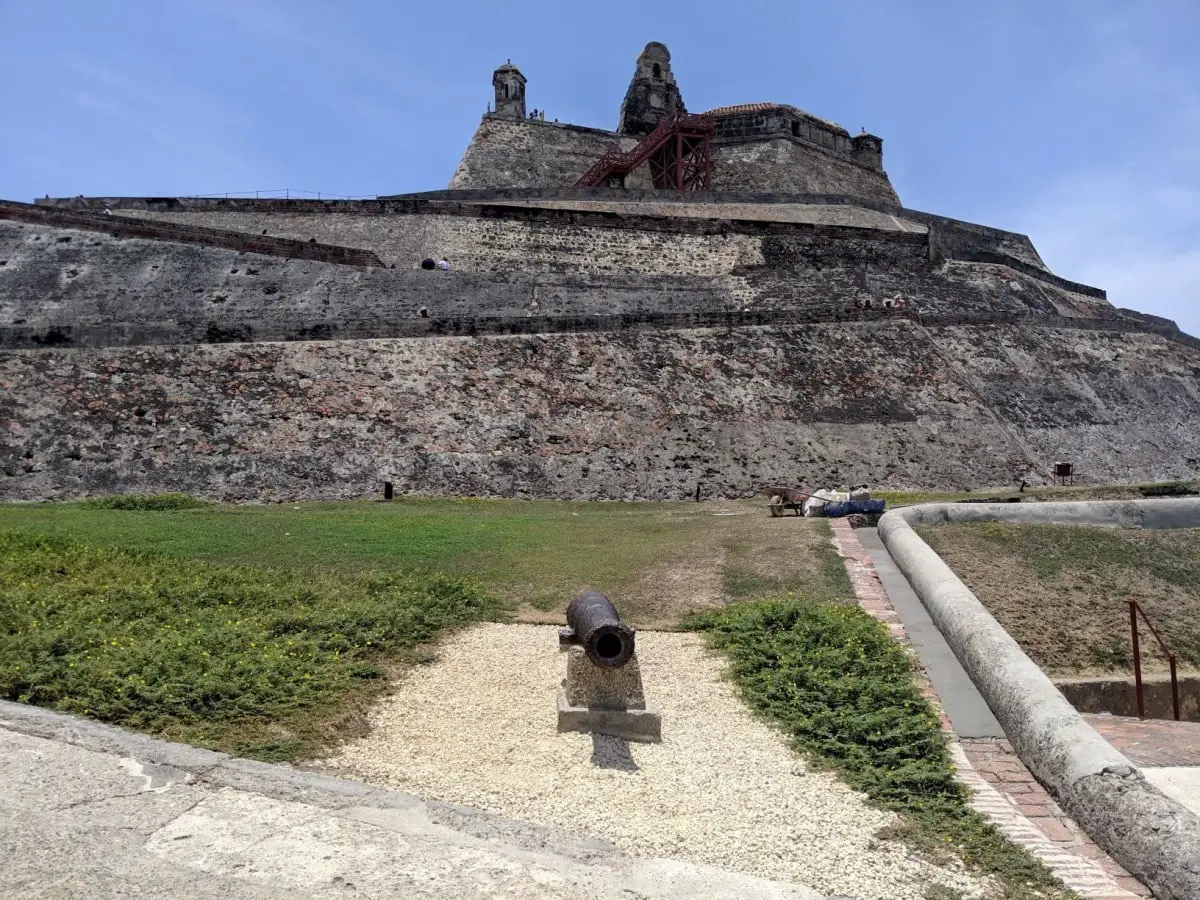
Castillo de San Felipe de Baraja is a fortress in Cartagena, Colombia.
It was built by the Spanish in the colonial Era and sits atop San Lazaro Hill overlooking the city and sea. The fortress has been attacked many times, including the 1697 raid on Cartagena and the 1741 battle of Cartagena De Indias. It’s pretty well preserved, and a fantastic place to visit on a trip to Cartagena if you are interested in learning about the history of the city. The view of the city from the top of the fortress is worth it in itself.
In the fortress, you can find plaques that will tell you about the history and a movie in Spanish but with English subtitles. There are towers you can climb and tunnels you can explore. If you are visiting during peak times, make sure you visit in the morning right when it opens because it gets really crowded and can get pretty hot & humid.
El Tatio, Atacama, Chile
Explored by Lori from Travelin Mad
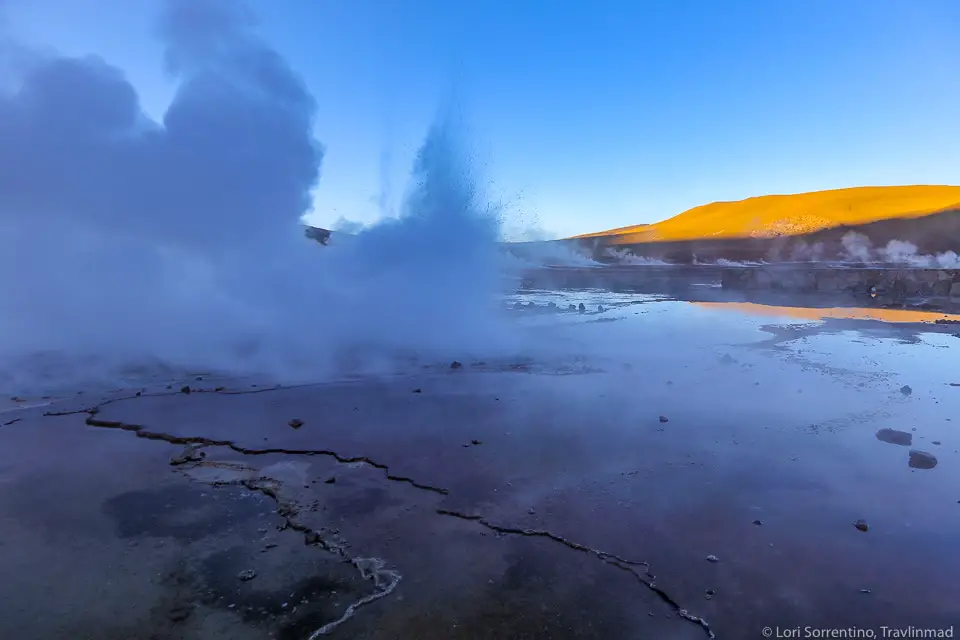
The Atacama Desert in northern Chile may be unlike anywhere you’ve ever been, unless of course, you’ve walked on the Moon.
Spanning across four South American countries of Peru, Bolivia, Chile and Argentina — though Chile claims the largest part — the Atacama is the world’s driest non-polar desert and an adventure lover’s paradise. Hiking and exploring the natural landscape is incredible here, from salty altiplanic lagoons to the parched desert dunes of Death Valley.
But perhaps the most iconic natural landmark in the Atacama is El Tatio, the thermal geyser field famous for its scalding hot geysers. El Tatio is the highest geothermal field in the world at nearly 14,000 feet. In the early morning hours, impressive steam fumaroles are most active gushing super-heated water way up high, and creating plumes of steam in the cold mountain air. The area is covered with mineral deposits and thermal ponds and is surrounded by mountains reaching over 19,000 feet.
You can drive yourself to the geyser field or take a pre-dawn tour and leave driving in complete darkness to the professionals. The road to the geysers reveals some of the most epic lunar landscapes you’re likely to see in South America, dotted here and there by wetland areas teeming with nature, an odd juxtaposition against the arid desert climate.
Be sure and stay for a swim in the nearby hot springs. And at the end of the day, the brilliant night sky in the Atacama is your reward for such great adventures.
Iguazu Falls, Brazil & Argentina
Explored by Vicky from Buddy The Traveling Monkey
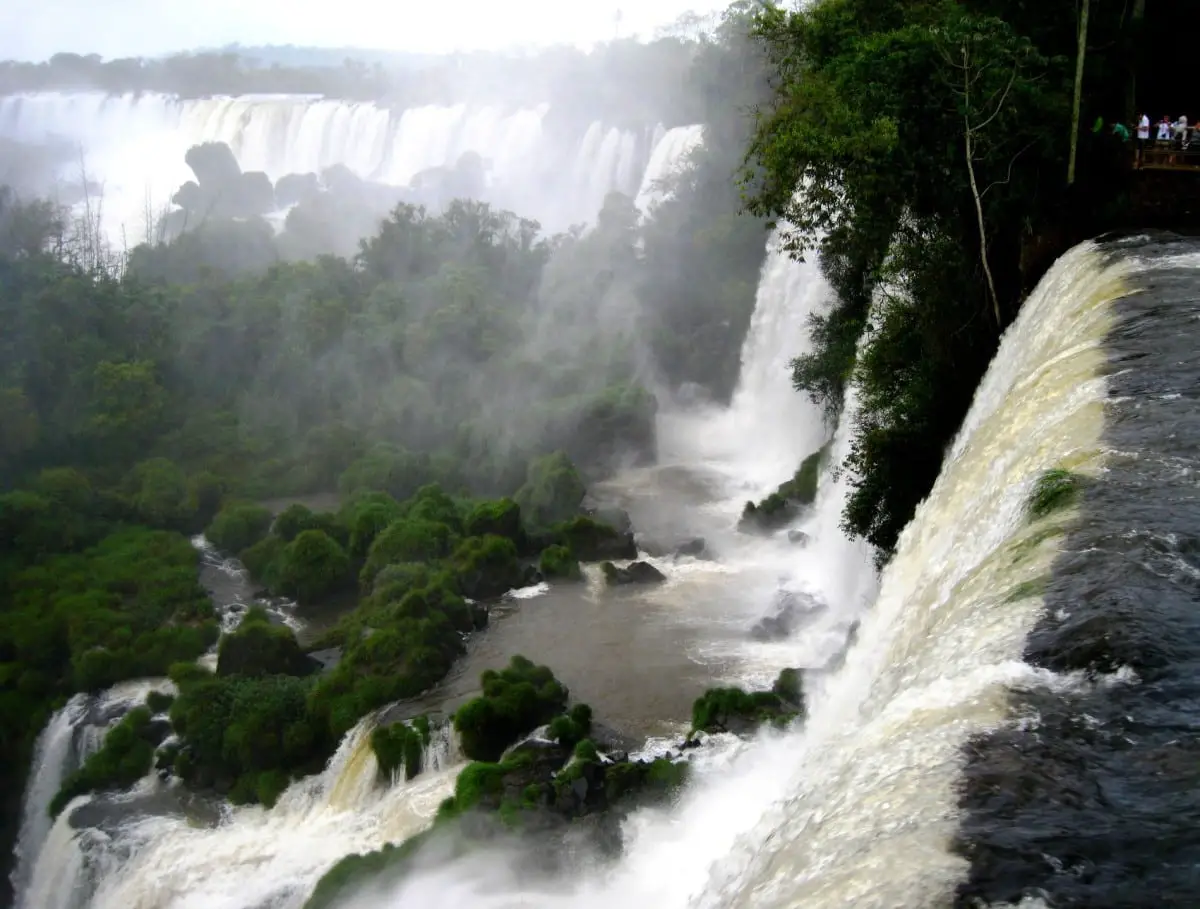
Iguazu Falls National Park is a UNESCO World Natural Heritage Site in Argentina. This amazing park has over 275 waterfalls! The tallest of these is called Devil’s Throat and is 262 feet tall. While at the park there are multiple trails so you can get really close to waterfalls and even walk over some.
Admission is roughly $25 and it includes entry into the park, a ride on the Jungle Train, and entrance into the Nature Interpretation Center. You can also pay extra for a Full Moon Walk or to take the boat that takes you almost right under the falls.
I thought the Jungle Train was really cool because it’s an eco-friendly train that runs on liquefied petroleum gas and was designed exclusively for Iguazu Falls National Park. There is a lot to see at Iguazu, so if you have time, we recommend spending a second day there. If you do plan to return, you can get your ticket validated at the front ticket booth on your way out and get the next day’s ticket at 50% off.
If you’re in the area, I really encourage you to visit this incredible landmark. Flights are easy to get from Buenos Aires and there’s a public bus in town that takes you directly to the park. I ended up visiting Iguazu Falls as a solo traveler and loved every second of the trip. I was able to take my time at the waterfalls and really take in the incredible scenery around me.
Lake Titicaca, Peru & Bolivia
Explored by Jeanine from Le Wild Explorer
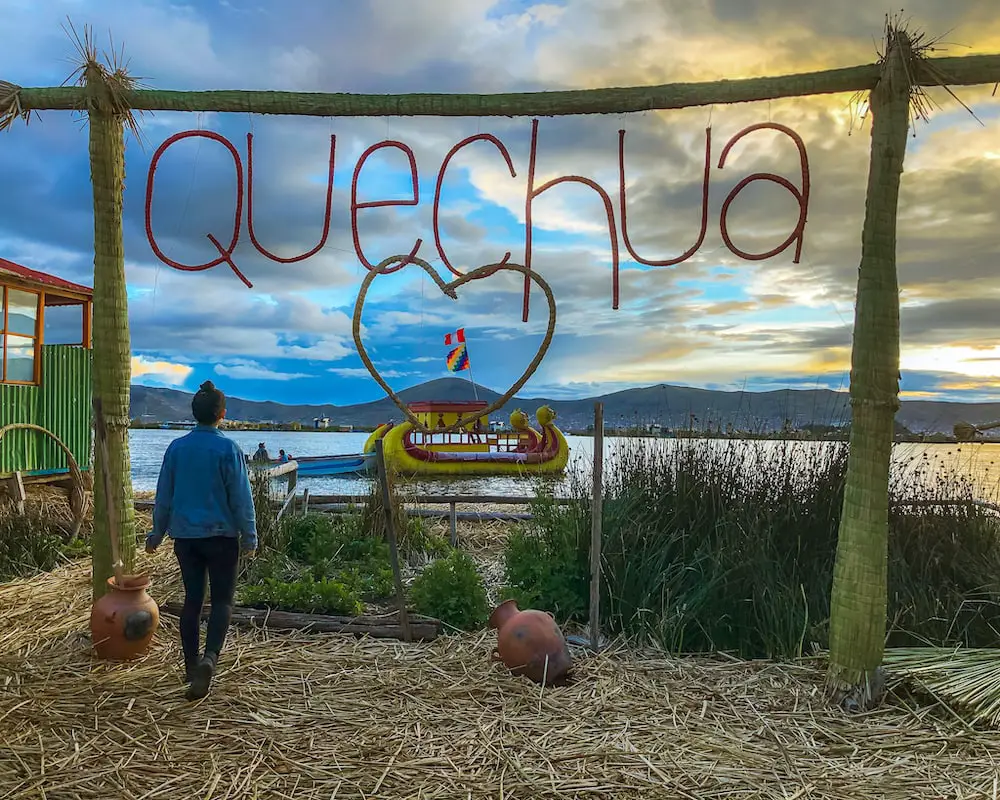
South America is full of amazing places and a lot of natural beauty. You have stunning beaches, majestic mountains, and beautiful lakes. And the most famous lake and largest in the continent is Lake Titicaca, located in between Peru and Bolivia. A visit to Lake Titicaca is a must-see landmark in South America. There are many ways to experience the lake but a visit to the lake is best.
There are a series of islands you can check out as a day tour or even stay the night. Those islands include Taquile, Amantaní, Suasi, and the most popular, Uros in Peru. Uros is a series of manmade floating islands. It’s home to around 1,200 people. The Uros people are indigenous to the area and have been living these islands for 3,700 years. Visiting the Uros Islands of Lake Titicaca is a unique experience you won’t forget.
You’ll need to head to Puno to get to the islands. There are direct buses from Arequipa, Peru, and Copacabana, Bolivia or you can fly into Juliaca airport which is a 50-minute taxi ride away. Alternatively, you can take a 10.5-hour scenic train ride from Cusco.
The islands are perfect for those looking to relax and disconnect. Don’t expect WiFi and definitely bring some snacks and wine or beer. Enjoy the beautiful sunsets, take a swim, and enjoy the beauty of Lake Titicaca.
Rainbow Mountain, Peru
Explored by Gigi from Beach Addicted
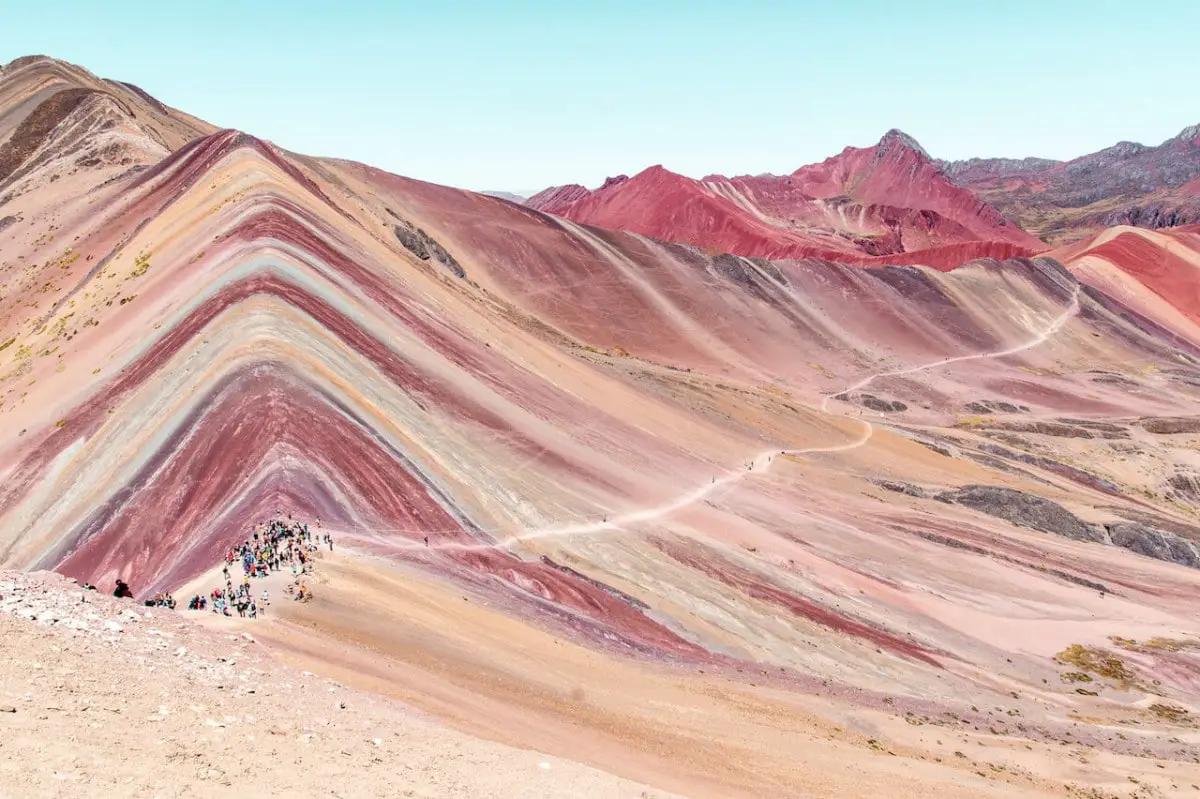
If you are traveling to Peru, you will be very likely to visit Cusco and Machu Picchu. However, Cusco is also the gateway to several other beautiful landmarks, including Rainbow mountain.
I am sure almost everyone has seen this particular mountain, dreamily painted in 7 colours, on Instagram. Rainbow Mountain, or also named Mountain of 7 Colours or Vinicunca, is an extremely beautiful and special place.
There are several tips that you should know before visiting Rainbow Mountain. Rainbow Mountain is located at a very high altitude, so before your hike, make sure you acclimate your body, make sure you drink enough and rest beforehand.
It will take you around 1.5 hours to reach the peak of the Rainbow Mountain, where you will have this amazing view.
If you have a problem breathing, there is also a possibility to hire a horse (which I did). Most of the tours start very early, so be ready to wake up at 4.00am. Local breakfast and lunch are usually included in the tour, but make sure to pack some sugary snacks, enough water, and coca leaves to avoid altitude sickness.
If you have more strength, you can continue hiking onwards through the Red Valley, which is in total an 8-hour trek.
Basílica del Voto Nacional, Ecuador
Explored by Sydney from A World in Reach
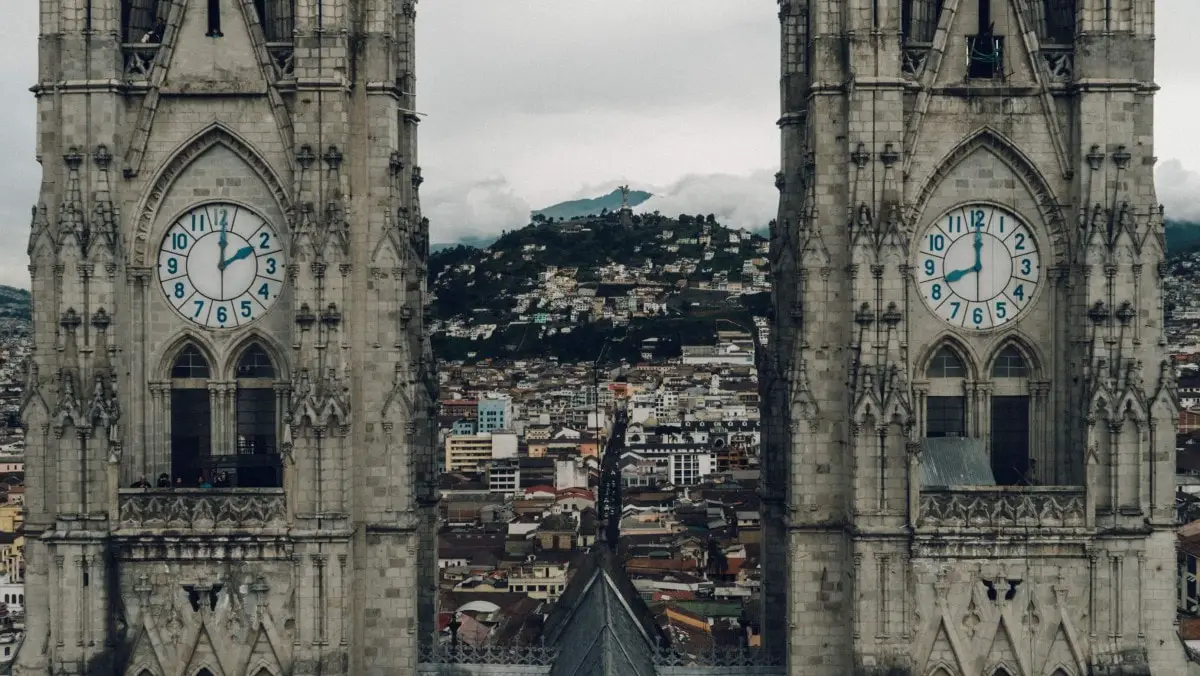
Quito, Ecuador’s Old Town is home to an abundance of gorgeous, historical churches, but the Basílica del Voto Nacional (Basilica of the National Vow) is one of the most magnificent ones in the city. This beautiful Roman Catholic church is the oldest neo-Gothic Basilica in the Americas and is the largest church in Quito.
The history of the Basílica del Voto Nacional is fascinating. Construction on the massive church began in 1892 and lasted for several decades – technically, it is still ongoing. Legend has it that the world will end when construction on the church is complete.
Visiting the Basílica del Voto Nacional is a must when spending a few days in Quito. For just a $2 entry fee, you can enter the basilica and see its beauty up close. The church is absolutely huge – to fully appreciate it, make sure to give yourself plenty of time for the visit so that you can explore the nave (and see the gorgeous stained glass windows), the various chapels, and other spots within the church.
The highlight of your visit will definitely be climbing the towers – it’s a long climb with a lot of steps, but you will be rewarded with sweeping views of the city below. Before you leave, make sure to keep an eye out for the church’s gargoyles representing native Ecuadorian animals!
Huacachina, Peru
Explored by Aleah from Solitary Wanderer
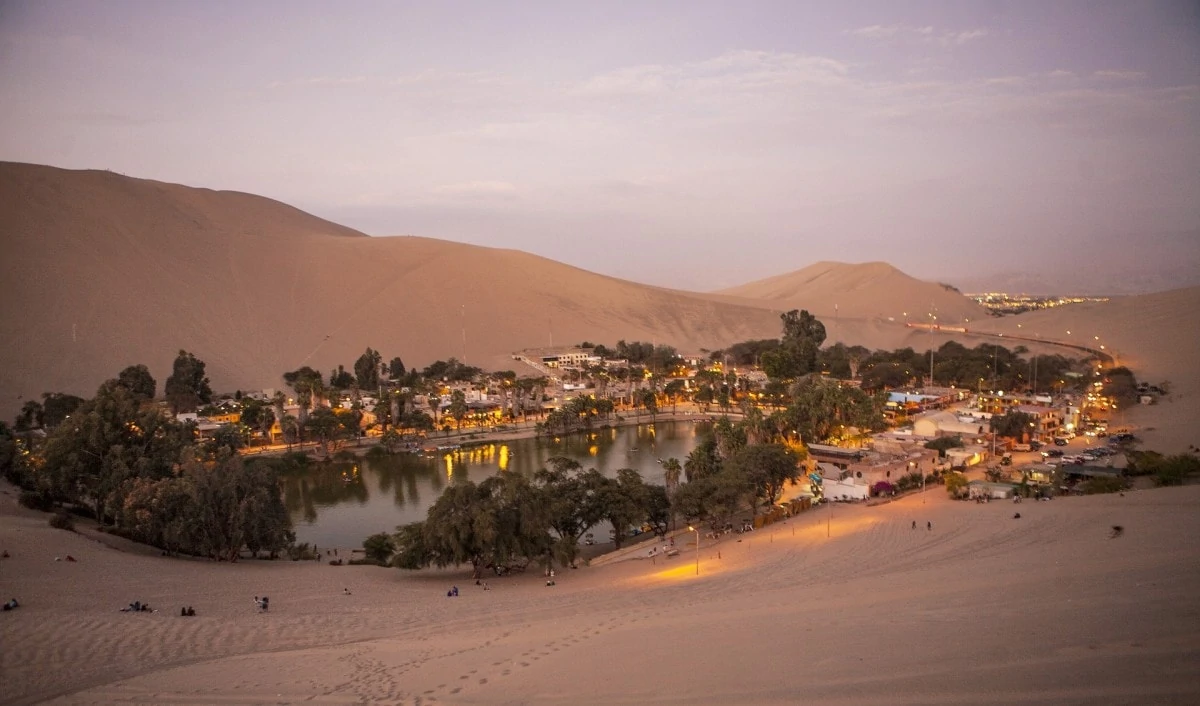
Peru is, of course, best known for Machu Picchu. You should definitely go there when you’re in Cusco. However, another place worth visiting as well is Huacachina. A bus from Cusco can take 15 hours, which only stops in Ica; from Ica, you can take a taxi there (it is a very short ride). Alternatively, if you have a Peru Hop ticket, they have direct trips from Cusco.
Huacachina is said to be the only oasis in South America. The town itself is tiny. Establishments cluster around the small lake, and the majority of the population (more or less 100 people) are involved in the tourism industry. While the lake offers paddleboat rides, there is only one thing visitors want to do: go sandboarding.
Sandboarding is definitely something to experience. When you book a package, you’ll be taken on a buggy ride around the dunes. Some of those sand dunes can be hundreds of feet high and going down the dunes brings on a rush of adrenaline that you’ll remember for weeks afterwards. If you have skied before, it’s also possible to go skiing; just tell your guide beforehand so you can get the proper equipment before heading to the dunes.
If you have no experience skiing, snowboarding, or sandboarding, your guide will tell you what to do. You can also go bodyboarding (like I did), which entails lying down on your stomach on the board and hurtling downward. Still as exciting but less scary given you’re closer to the ground and unlikely to lose your balance.
Is it worth it to go sandboarding in Huacachina? Definitely. If you have time to check out other wonders in Peru aside from the Incan temples, make sure to check out the dunes in this small oasis.
Recommended: Find out what amazing landmarks and monuments made it onto the list of USA landmarks.
So, what do you think of our list of the ultimate landmarks in South America? Are there any that you think we’ve missed off and should be added to the list? Let us know in the comments below.
Want to save this for later? Why not pin it…
